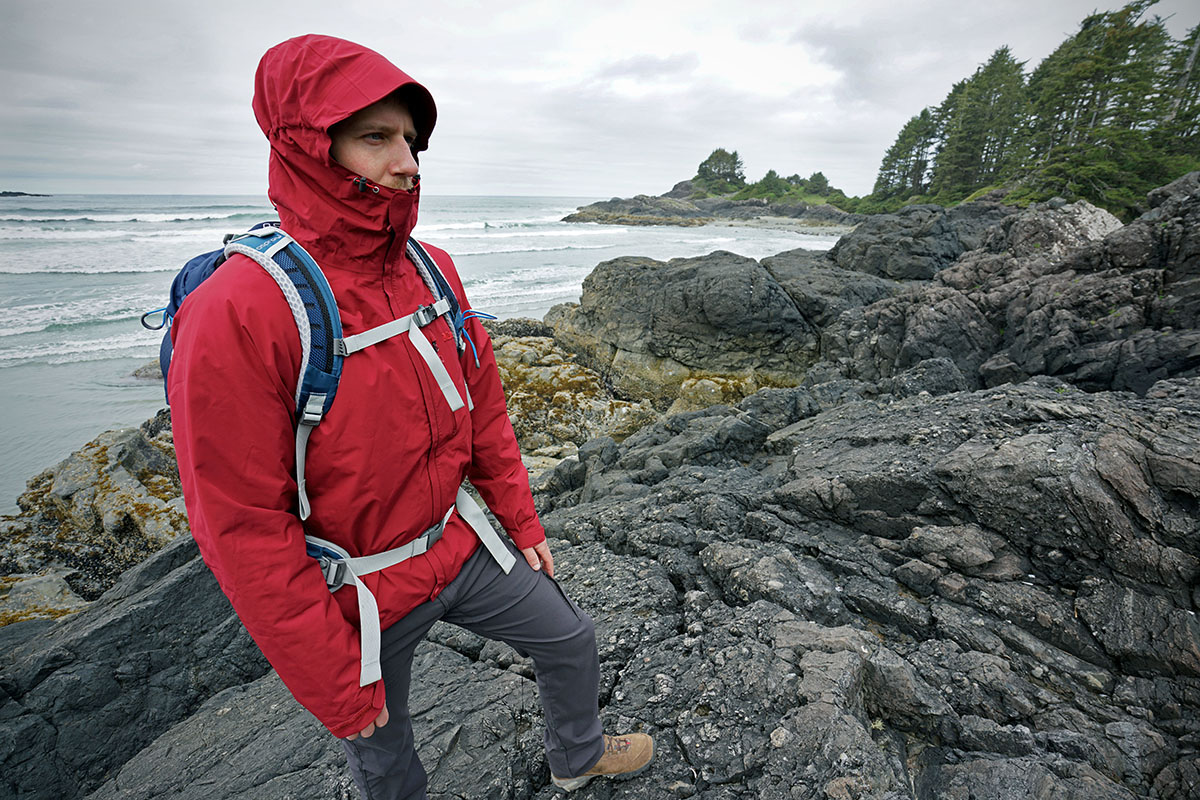
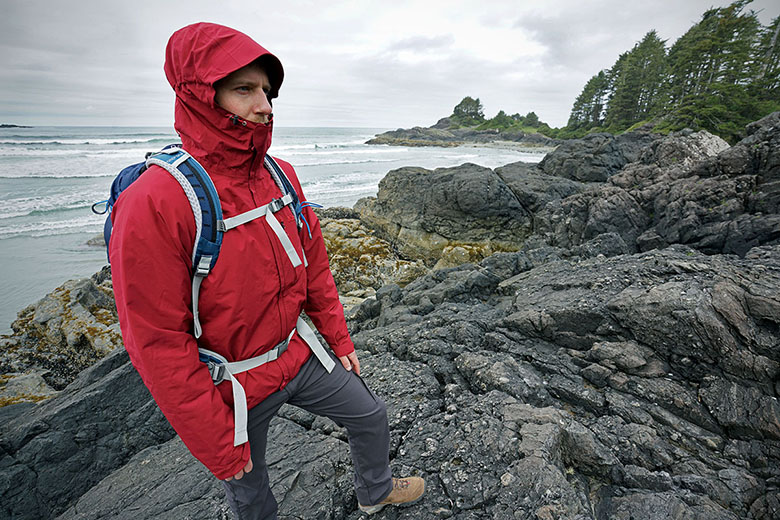
Switchback Travel


Switchback Travel
Here in the Pacific Northwest, we know a thing or two about rain. From months of daily drizzle to heavy downpours in the mountains, we're acutely aware of the benefits of a quality waterproof and breathable shell—not only for ensuring a more pleasant backcountry experience, but for keeping you safe when temps plummet and Thor's hammer strikes. We put over 20 leading designs through grueling, real-world tests to gauge their performance and reliability. Below we break down the best rain jackets of 2024, from entry-level models for hiking and daily use to performance pieces for backpacking and climbing. For more background information, see our rain jacket comparison table and buying advice below the picks. Of note: This article includes styles for both men and women, but we’ve also written a dedicated round-up on the best women’s rain jackets.
Editor’s note: We updated our rain jackets round-up on April 12, 2024, to include feedback on the updated Outdoor Research Foray II and Black Diamond Highline Stretch shells. We also added information about our testing practices and made sure our product selection was up to date with current prices and designs.
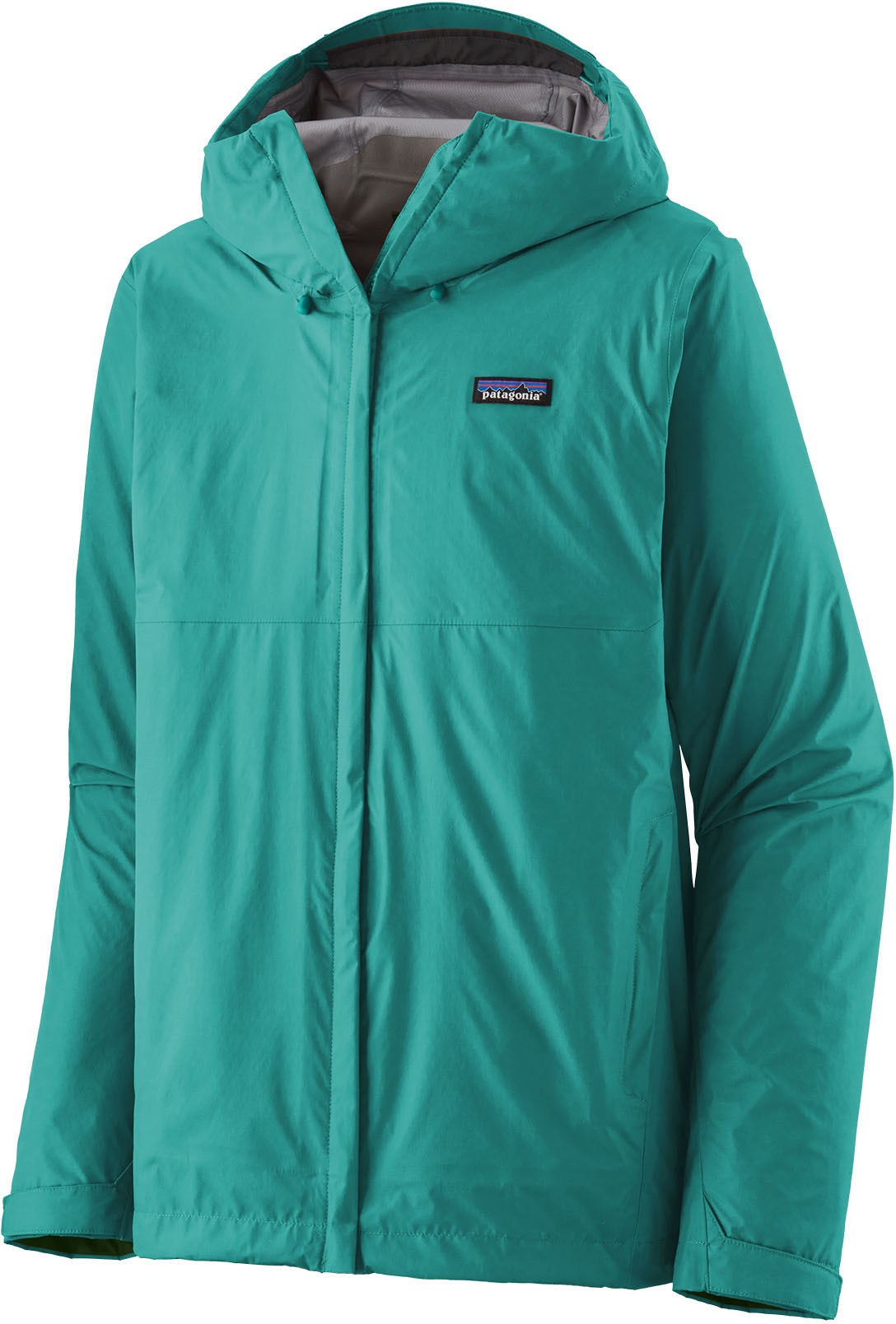 Category: Daily use/hiking
Category: Daily use/hiking
Weight: 14.1 oz.
Waterproofing: 3L H2No Performance Standard
What we like: 3-layer performance, quality materials, and good looks at an excellent price.
What we don’t: A bit crinkly and stiff; no chest pocket.
Patagonia shook up the rain jacket market with the release of its Torrentshell 3L a few years ago. The jacket’s hardshell-like 3-layer construction (hence the “3L” in the name) is highly protective and durable, plus the interior’s soft-touch tricot lining boosts comfort and limits the clammy feeling that’s typical among sub-$200 rain jackets. In testing, material quality has been a common theme: Everything from the thick-toothed main zipper to the pit zips and three-way adjustable hood have a solid and reliable feel. Tack on sleek Patagonia styling, a wide variety of available colorways, a PFC-free DWR coating (to go along with the 100%-recycled face fabric), and an approachable $179 price tag, and the versatile Torrentshell 3L currently is our favorite overall rain jacket.
A notable downside of the Torrentshell’s durable construction is that it’s stiffer and crinklier than competitors like the Marmot Minimalist and Black Diamond StormLine below (it does break in and loosen up a bit over time). Additionally, you miss out on a chest pocket, and the shell isn’t a weight or packed size leader. In the end, if you want a high-performance piece for serious outdoor use, you may want to up your budget to an alternative like the Arc’teryx Beta LT below. But we think the vast majority of folks will find the Torrentshell to be a near-perfect match for everyday and light backcountry use. For its reasonable $179 MSRP, you’ll be hard-pressed to find a better-made, better-looking, or more protective shell... Read in-depth review
See the Men's Patagonia Torrentshell 3L See the Women's Patagonia Torrentshell 3L
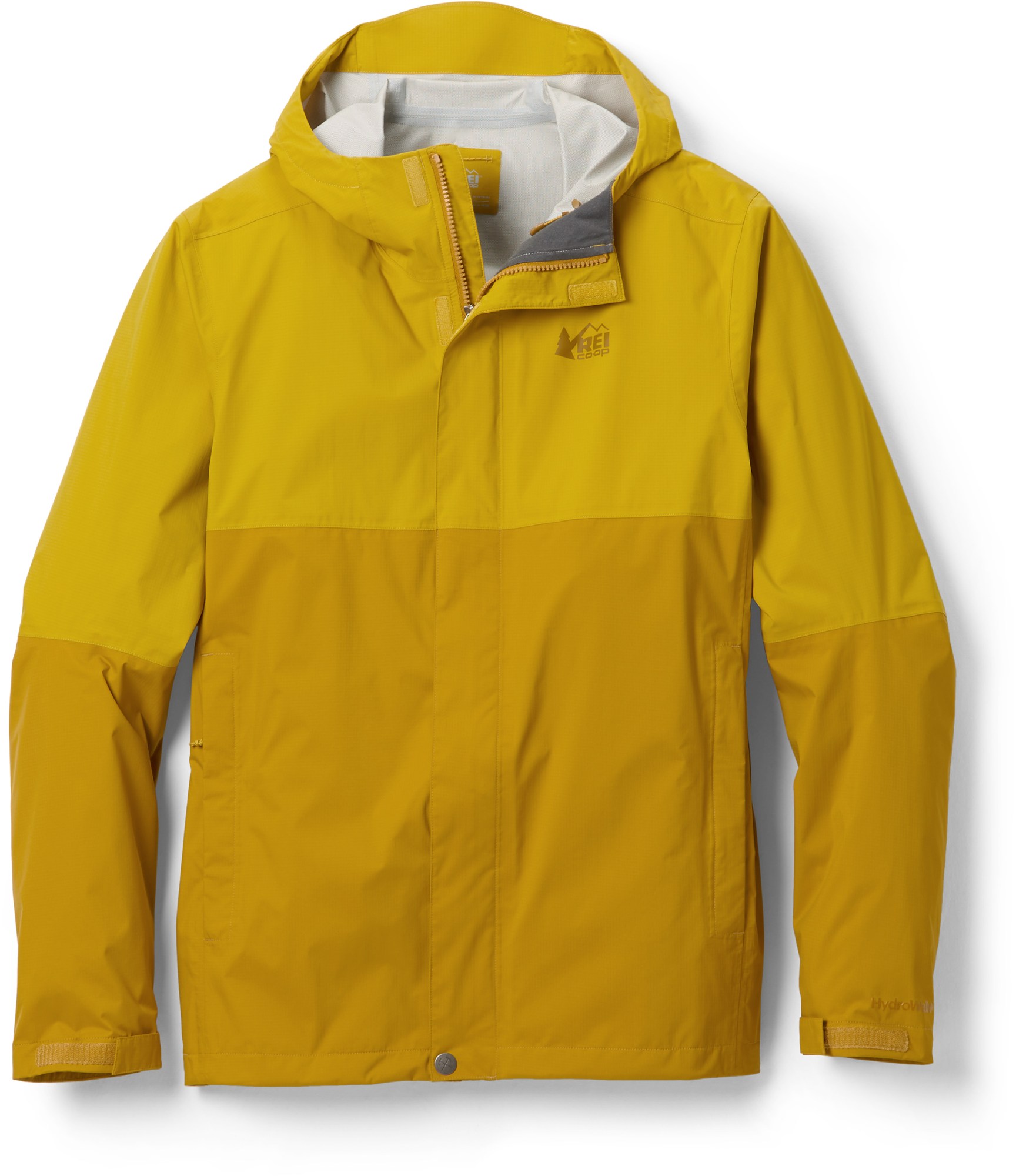 Category: Daily use/hiking
Category: Daily use/hiking
Weight: 11.3 oz.
Waterproofing: 2.5L HydroWall
What we like: Great price for a solid all-around design; wide range of colors and sizes.
What we don’t: Fits very big, so we ended up sizing down.
REI’s in-house line of rain shells continues to impress us when it comes to bang for your buck, and the popular Rainier is no exception. Overall, we think they’ve put together a solid product: The in-house 2.5-layer construction (recently updated to REI's HydroWall membrane) holds up well in all-day drizzle, pit zips help keep cool you on the go, and the clean styling wears well just about anywhere. REI also improved comfort with a softer and quieter face fabric on the latest model without increasing the cost, which we appreciate. Tack on REI’s excellent warranty and a wide range of colorways and available sizes, and you get a quality, budget-friendly rain shell for anything from city commutes to summer hiking and backpacking trips.
In testing the Rainier, we were struck with how many features it shares with Marmot’s PreCip Eco below. Everything from the REI’s hood design to pocket layout and even smaller touches like mesh pockets and the Velcro covering the center zipper reminded us of the Marmot shell. How do they differ? Most notably, we found the fit of the Rainier to be very large (depending on how you plan to layer underneath, it may be best to go down a full size). In addition, the REI has a slightly more substantial face fabric and improved comfort with a fleece-like lining covering the collar (weight goes up a bit as a result). It’s a close call between the two, but as long as you can get a good fit, we think the REI’s modest improvements in comfort and durability give it the edge.
See the Men's REI Co-op Rainier See the Women's REI Co-op Rainier
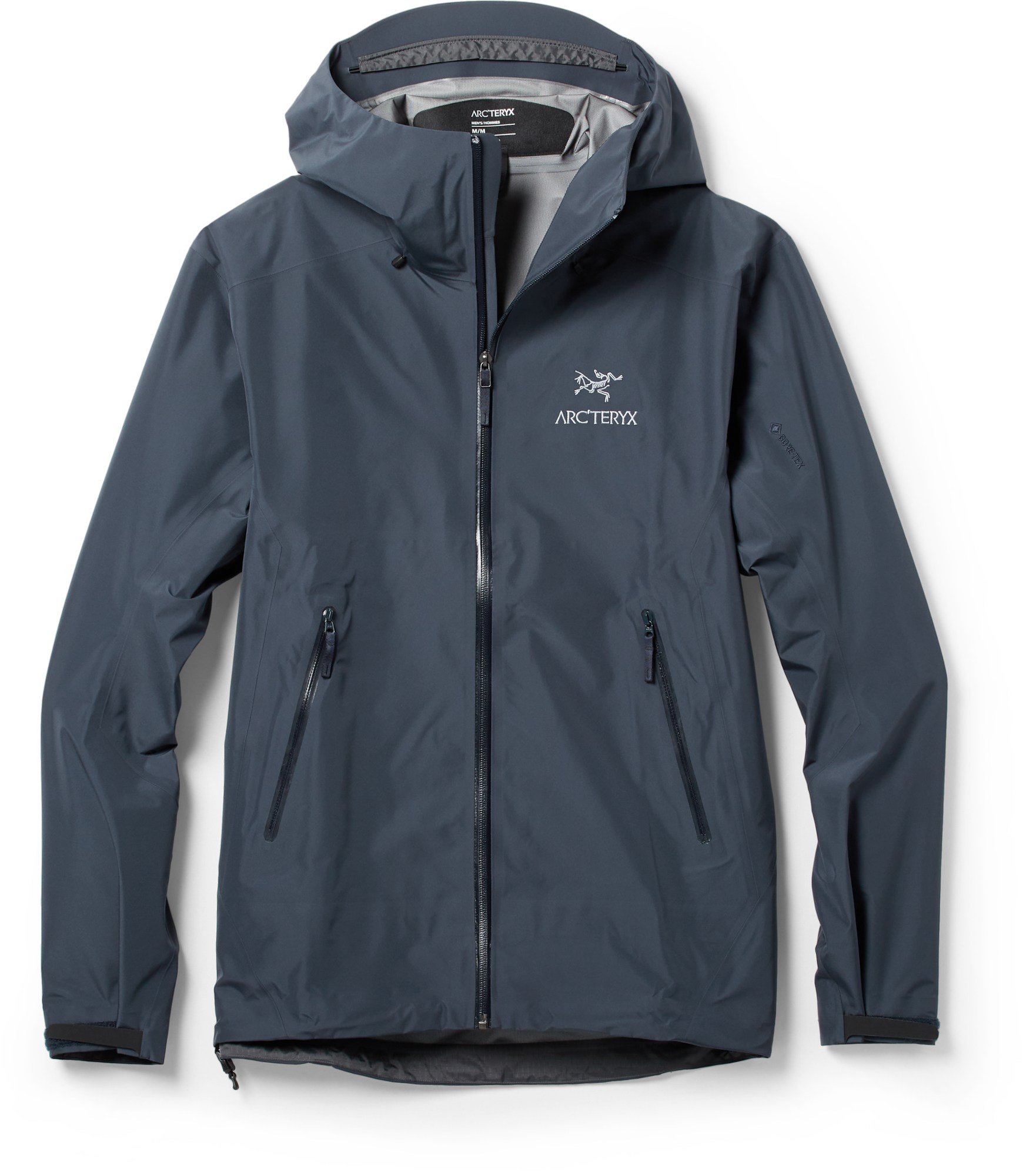 Category: Performance/hiking
Category: Performance/hiking
Weight: 13.9 oz.
Waterproofing: 3L Gore-Tex
What we like: Strong combination of weight-savings, protection, and performance-oriented features.
What we don’t: The priciest rain jacket on our list at $450.
Arc’teryx is known for top-of-the-line quality and prices to match, and the British Columbia-based brand has long been our go-to for premium weather protection. With a recent reconfiguration of their lineup, they’ve moved their rain shells away from the Zeta collection into the versatile Beta series. Combining 3-layer Gore-Tex construction with a host of technical features (including a helmet-compatible hood and pit zips), the Beta LT blurs the line between rain jacket and hardshell and delivers trustworthy performance for four-season hiking and backcountry exploring. And as we’ve come to expect from the brand, all of the Beta LT’s details are nicely sorted, with premium seam taping, streamlined seams, and a fit that is reasonably trim but roomy enough for layering.
What’s not to like with the Beta LT? Most significant is the price: At a whopping $450, it’s the most expensive rain jacket here and arguably overkill for summer backpacking or around-town use. The Beta below will save you over 3 ounces and $50, and many users will appreciate the more simplified feature set. But for skiing, climbing, or bike commuting, we appreciate the LT’s more hardwearing 40-denier shell (the Beta is 30D), and the helmet-compatible hood and pit zips are an undeniable benefit for those really getting after it. All told, if you’re looking for versatile rain and snow protection but don’t want to spring for a full-on Gore-Tex Pro hardshell, the Beta LT is hard to beat. Note: Arc'teryx also offers the Beta Lightweight Jacket, which shaves off around 2 ounces, uses a slightly thicker shell fabric (40D x 70D), tacks on an internal chest pocket, and uses Gore's new—and more sustainably built—ePE membrane for $50 more than the LT... Read in-depth review
See the Men's Arc'teryx Beta LT See the Women's Arc'teryx Beta LT
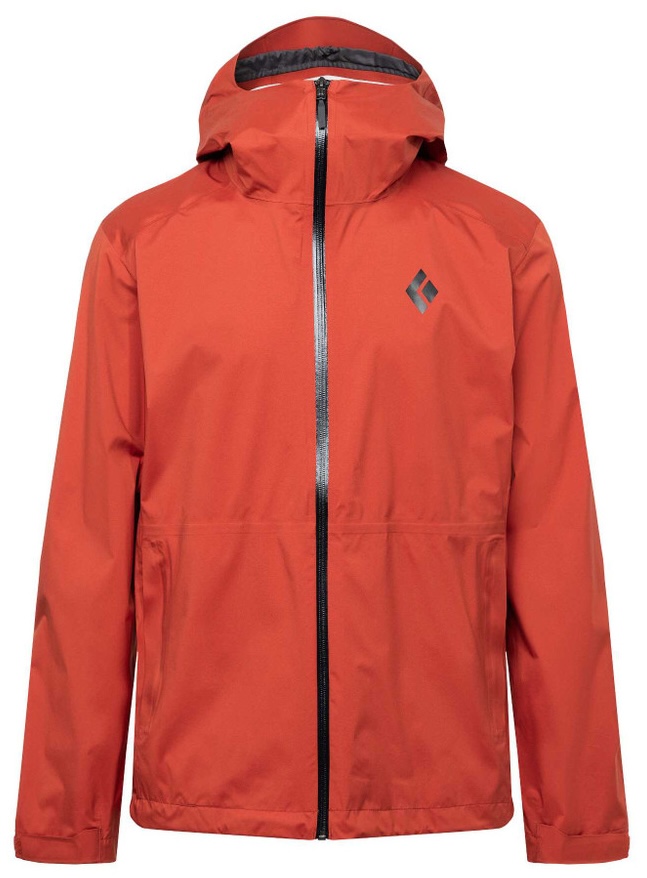 Category: Hiking/daily use
Category: Hiking/daily use
Weight: 11.3 oz.
Waterproofing: 2.5L BD.dry
What we like: Stretchy, loaded with features, and affordable.
What we don’t: Large fit doesn’t match its performance intent; not the most breathable design.
Black Diamond took the plunge into the rain shell market with their StormLine. The big news is the stretchy 2.5-layer construction, which offers greater comfort than a standard rain jacket like the REI Rainier above. The interior is soft to the touch and doesn’t have the plasticky feel that you get with most traditional designs, and there’s a noticeable amount of “give” in the shell fabric. The jacket also is well equipped and competitively lightweight with two hand pockets, a coated front zipper, and an all-in weight of 10 ounces (for our men’s medium). To top it off, the StormLine is aggressively priced at $180.
Features like a helmet-compatible hood, stuff pocket, and pit zips give the StormLine a clear performance slant, but the large fit isn’t ideal for the backcountry. It’s easy to layer a puffy underneath, but the jacket was much too long and roomy for us when wearing it over a thin baselayer (sizing down can help). We also found breathability to be lacking, which led to a clammy and sticky-feeling interior when working up a sweat (this was especially noticeable when stuffing wet hands into the pockets). But it’s hard to beat the StormLine’s combination of weight, comfort, and price, earning it our vote as the best stretchy design this season. One final note here: Black Diamond recently expanded the StormLine collection to include an Anorak version ($165), which boasts a half-zip front and zippered kangaroo pocket... Read in-depth review
See the Men's BD StormLine Stretch See the Women's BD StormLine Stretch
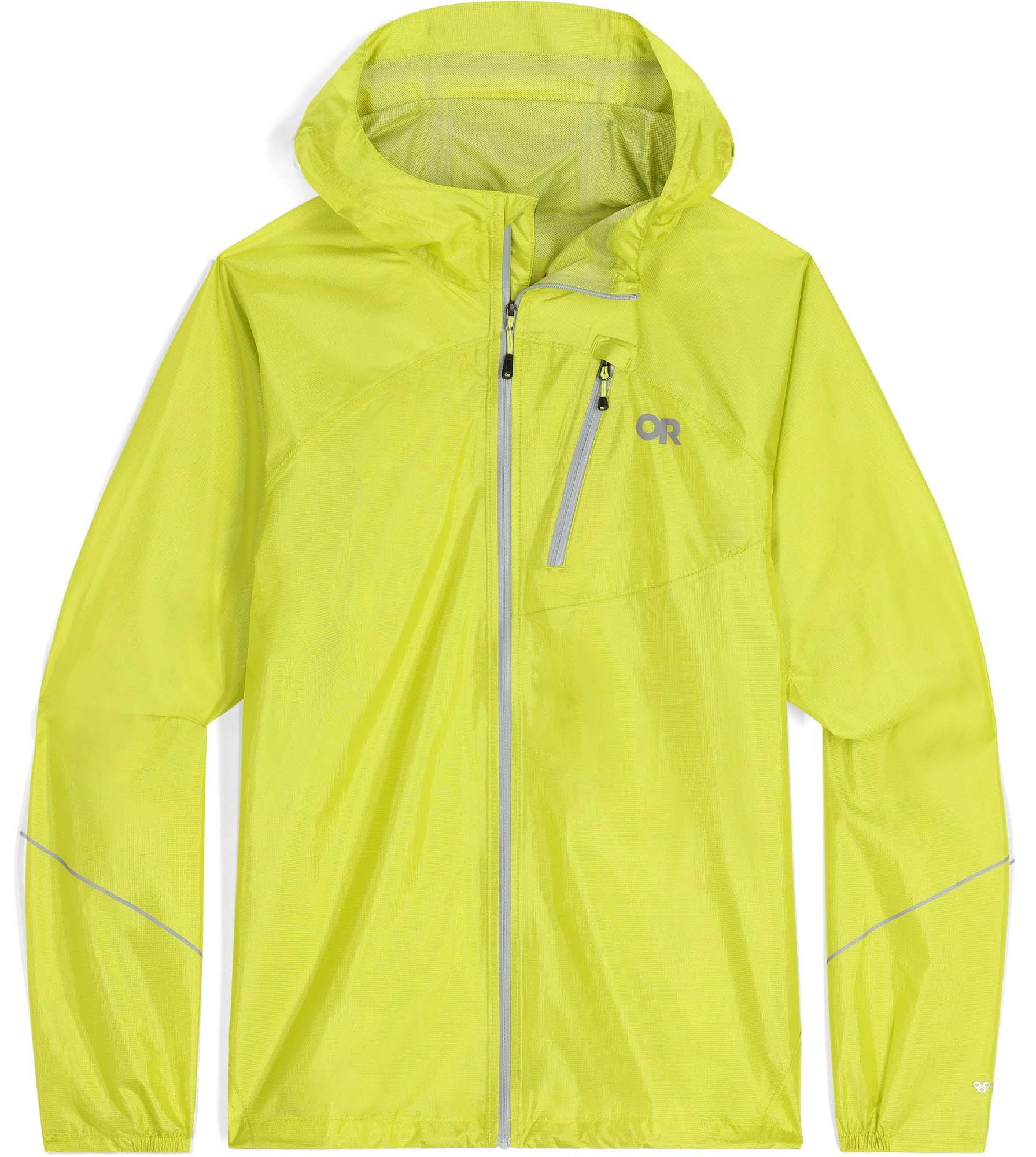 Category: Hiking
Category: Hiking
Weight: 6.2 oz.
Waterproofing: 2.5L Pertex Shield Diamond Fuse
What we like: Ultralight yet reasonably tough.
What we don’t: Too streamlined for around-town use; doesn’t breathe very well.
A longtime ultralight favorite, Outdoor Research’s Helium Rain Jacket, was overhauled a few seasons back. The most notable update was the inclusion of Pertex’s Diamond Fuse fabric, which boosts durability and tear resistance without a weight penalty. Moreover, Outdoor Research updated the fit to a trimmer cut, and the jacket now stuffs into its exterior chest pocket. In testing the Helium Rain, we found it remains a solid ultralight/emergency piece: The 2.5-layer build and DWR coating can handle light to moderate rainfall, the adjustable hood offers good all-around coverage, and its small packed size is ideal for activities ranging from hiking and backpacking to climbing.
What are the compromises in choosing the Helium Rain? Heavy downpours can overwhelm the thin build, causing the fabric to absorb moisture and feel wet against your skin. Further, you miss out on hand pockets, which means the only storage option is the single chest pocket. Finally, it doesn’t excel for true performance use—the lining is prone to getting slippery and clammy and there are no pit zips to dump heat. But these complaints are to be expected in a sub-7-ounce shell, and the Helium Rain’s low weight and impressive packability, reasonable price, and surprisingly good toughness make it our top ultralight pick... Read in-depth review
See the Men's Outdoor Research Helium See the Women's Outdoor Research Helium
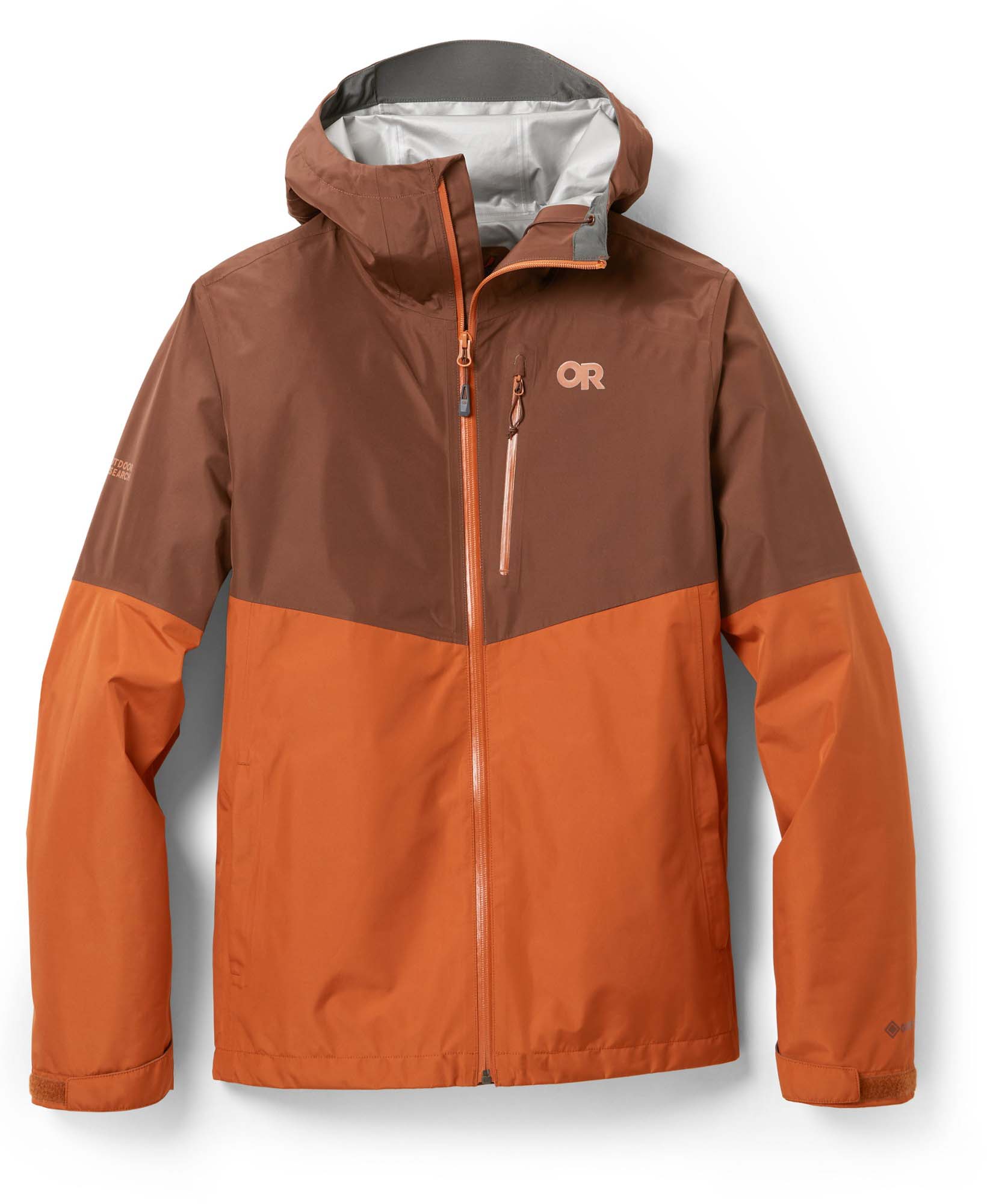 Category: Hiking/performance
Category: Hiking/performance
Weight: 11 oz.
Waterproofing: 2L Gore-Tex Paclite
What we like: Well-rounded performance, excellent durability, and class-leading venting for everything from hiking to spring skiing.
What we don’t: Lining feels clammy against bare skin when working hard; TorsoFlo vents are a little polarizing for casual use.
We love what Outdoor Research has done with the Foray (and women’s Aspire), a do-it-all rain jacket that can even work as a lightweight shell for spring skiing. Recently updated with a stronger sustainability focus, the popular design features a Gore-Tex Paclite waterproof laminate, smooth and comfortable interior, and tough 50-denier shell that’s both durable and highly weather-resistant. But what sets the Foray apart is its full-length side zips (called TorsoFlo) that extend from the armpit all the way to the bottom hem. When fully unzipped, this creates a poncho-like opening for awesome venting on the trail—a great way to dump excess heat while still retaining coverage.
In addition to incorporating recycled polyester and a PFAS-free DWR coating, the latest OR Foray II is also slightly lighter than its predecessor (by 0.9 oz.). But the overall formula remains the same, which we’re happy to see: The venting system is functional for a number of outdoor activities, and overall protection and durability are up to snuff for everything from three-season hiking and backpacking to the occasional mild-weather ski tour. To be sure, not everyone will be a fan of the full-length side zips, and the lining can feel clammy against bare skin during heart-pumping activities. But all things considered, the Foray and Aspire are excellent quiver-of-one rain jackets for the backpacker, spring skier, and daily wearer... Read in-depth review
See the Men's Outdoor Research Foray II See the Women's OR Aspire II
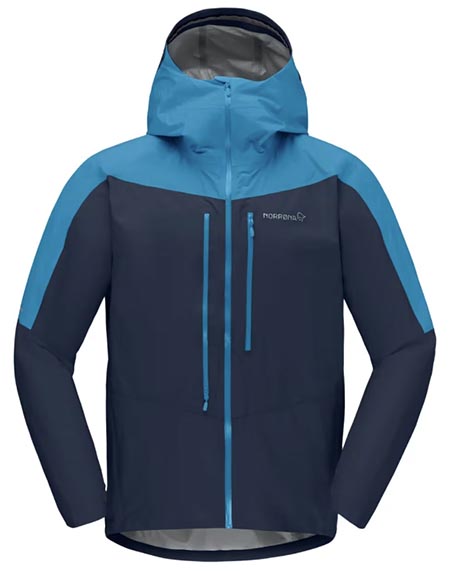 Category: Performance
Category: Performance
Weight: 9.1 oz.
Waterproofing: 2.5L Gore-Tex Paclite Plus
What we like: A minimalist shell that offers great protection and freedom of movement.
What we don’t: Expensive; middling breathability.
Norway-based Norrøna isn’t a household name in the U.S., but they offer a quality lineup of serious shells built for demanding backcountry pursuits. On a recent testing trip in Southern Patagonia, we fell in love with the Falketind Gore-Tex Paclite jacket, which offered reliable waterproofing alongside a fantastic fit and finish. Norrøna’s lightest and most packable waterproof jacket, the Falketind checks in at just 9.1 ounces and features a minimalist design with 20-denier nylon, one chest pocket, one chest vent, and simple adjustments at the hood, hem, and cuffs. For those looking to shave some weight from their pack without compromising weather protection, it’s a stellar choice.
The Falketind Gore-Tex Paclite is undeniably expensive at $349, especially considering it’s just a 2-layer design. As expected, breathability suffers as a result of this construction, which means the Norrøna is not our first choice for high-output activities. What’s more, the single core vent isn’t nearly as effective as pit zips at dumping excess heat. And again, you’re paying more for less, including limited storage and a thin shell that will need to be treated with care (especially around sharp objects like crampons, ice tools, and even abrasive rocks). But for slower-moving pursuits, the Falketind is a real standout—in fact, it was our shell of choice while alpine climbing in Patagonia due to its great mobility, harness-friendly cut, and excellent packability... Read in-depth review
See the Men's Norrøna Falketind Paclite See the Women's Norrøna Falketind Paclite
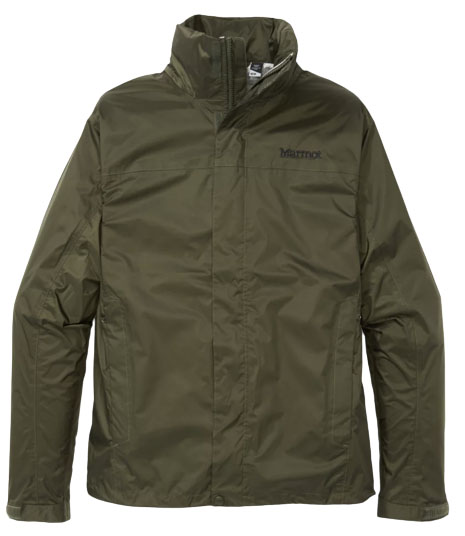 Category: Daily use/hiking
Category: Daily use/hiking
Weight: 11 oz.
Waterproofing: 2.5L NanoPro
What we like: Proven performance for a great price.
What we don’t: Feels more plasticky than many of the more modern jackets here.
In the world of rain jackets, Marmot just seems to get it, delivering good fit and performance at reasonable price points. The PreCip is their leading entry-level offering that’s reached iconic status among hikers, backpackers, and everyday wearers. For years, the formula has stayed largely the same: proven 2.5-layer waterproof construction that does well in light to moderate conditions, seam taping, and reasonable weight. You also get useful backcountry features like pit zips and a stuff pocket, and its adjustable hood provides full coverage in a rainstorm. For $120, there’s not much more you can ask for from a rain shell.
Marmot gave the PreCip a light revamp a few seasons back. What changed? Most notably, it now has “Eco” in its name thanks a recycled face fabric and a PFC-free DWR coating. There’s also an updated fit, although the jacket still has a regular cut that’s roomy enough for wearing a lightweight puffy underneath. All told, the REI Rainier above edges it out slightly in comfort and value (it's $20 less than the Marmot), and those wanting a high-end performance piece that’s stretchy and breathable should look elsewhere, but the PreCip remains a classic choice for mixed every day and hiking use... Read in-depth review
See the Men's Marmot PreCip Eco See the Women's Marmot PreCip Eco
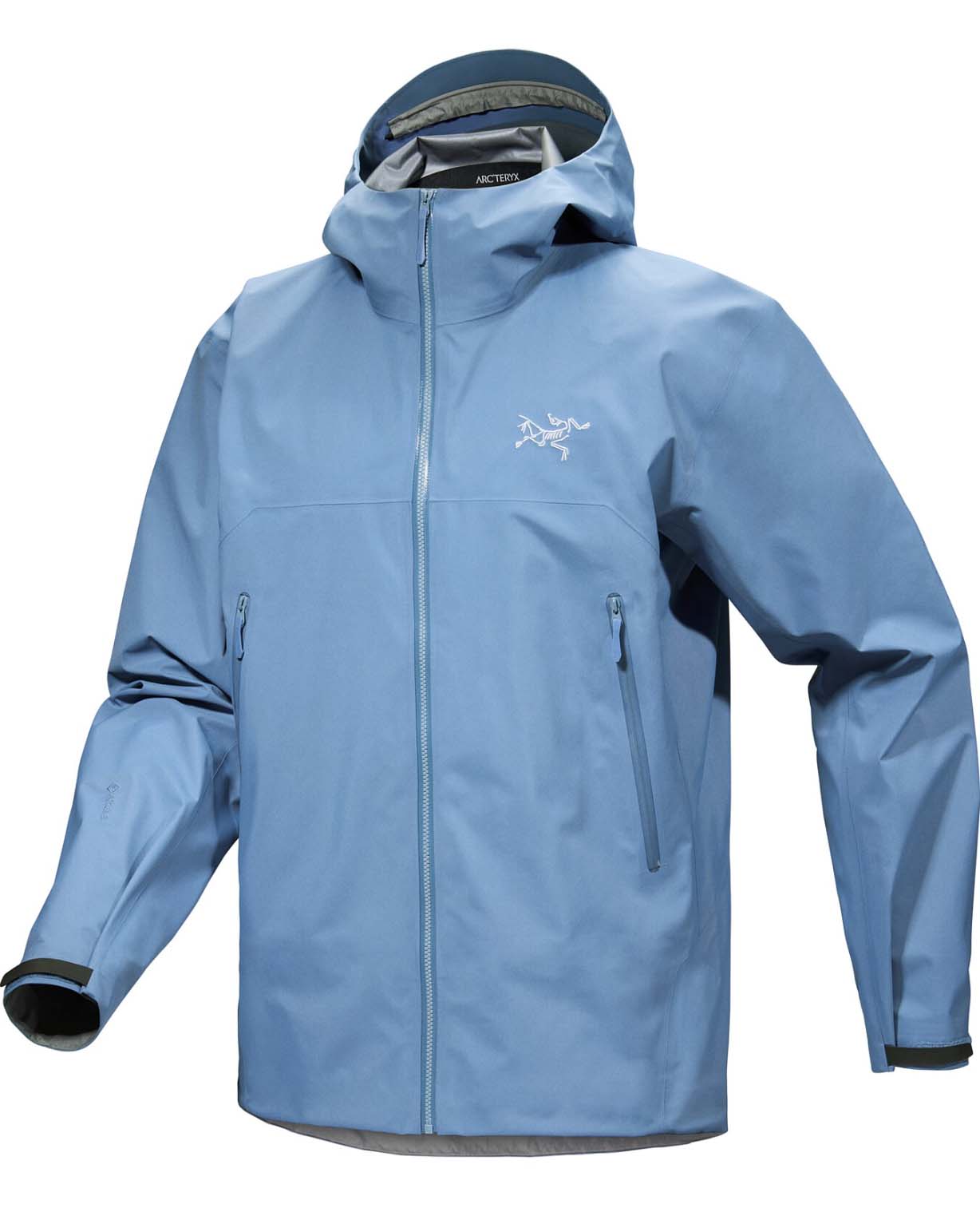 Category: Hiking/performance
Category: Hiking/performance
Weight: 13.2 oz.
Waterproofing: 3L Gore-Tex ePE
What we like: Premium weather protection alongside a casual feature set; latest update improved durability and added a nice sustainability slant.
What we don’t: Still no pit zips or helmet-compatible hood.
Released a couple seasons back, the Arc’teryx Beta offers a nice middle ground for those who want the premium weather protection of the Beta LT above alongside a more casual feature set. After testing the original version throughout the PNW and while backpacking in Patagonia, we came away very impressed with its all-around performance: it’s one of the only jackets on this list to feature 3-layer Gore-Tex waterproofing (which is about as premium as it gets for a rain shell), is super comfortable against the skin with Gore’s C-Knit backer, and has a sleek appearance that looks the part both on the trail and in the city. Overall, if you’re looking for a one-quiver rain shell for everything from hiking and backpacking to around-town use, the Beta is a strong contender.
Arc’teryx recently updated the Beta Jacket, and the changes bring mixed feelings. On one hand, they addressed our biggest concern with the past model: durability. In place of the original design’s thin, 30-denier shell, Arc’teryx swapped in a much beefier and more confidence-inspiring 80-denier fabric. They also upgraded to Gore’s latest ePE membrane, which is more environmentally friendly than standard Gore-Tex. On the flip side, the roomier fit and 2.6-ounce weight increase make the latest version less streamlined overall. And some of our smaller gripes remain, including no pit zips or a helmet-compatible hood. Despite these nitpicks, the Beta is a versatile, high-performance rain shell from one of the best brands in the business—and the latest update was a net positive, in our opinion... Read in-depth review
See the Men's Arc'teryx Beta Jacket See the Women's Arc'teryx Beta Jacket
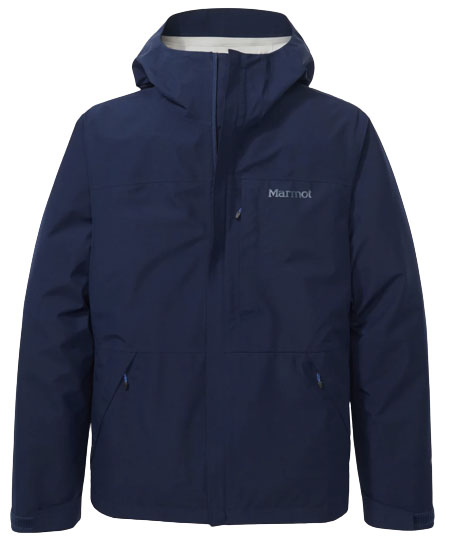 Category: Daily use/hiking
Category: Daily use/hiking
Weight: 13 oz.
Waterproofing: 2.5L Gore-Tex Paclite
What we like: Good-looking and solid Gore-Tex protection at a great price.
What we don’t: Current version feels cheaper than predecessors.
A longstanding favorite in the rain shell market, Marmot’s Minimalist balances classy looks with solid Gore-Tex protection. The 2-layer Paclite build resembles Outdoor Research’s Foray above, but with a smooth and clean exterior—including fabric flaps over the center zipper and hand pockets and a nice array of subdued colorways—the Minimalist is fully at home around town. For outdoor uses, the jacket is competitively light at 13 ounces, can be rolled into its hood for storage, and features pit zips to keep you comfortable on the move. Finally, Marmot upped their sustainability game with the most recent model, and the Minimalist now features a 100% recycled shell fabric and PFC-free DWR coating. For a reasonable $220, that adds up to a whole lot of jacket.
We’ve had the Minimalist ranked at or near the top of our list in prior years, but we felt the most recent update was a step backwards in most ways (besides the sustainability improvements mentioned above). Specifically, the jacket has lost its high-end feel: Prior models featured premium fabrics and thick and oversized touch points like zipper pulls and toggles, but the latest model feels plasticky and cheap by comparison. We also don’t like the center flap over the main zipper, which no longer has a button to secure it in place, is relatively small and flimsy, and is prone to folding open. In truth, these are relatively small complaints—and perhaps magnified because we liked the predecessor so much. But we’d love if Marmot brought back the high-quality look and feel of the old Minimalist... Read in-depth review
See the Men's Marmot Minimalist See the Women's Marmot Minimalist
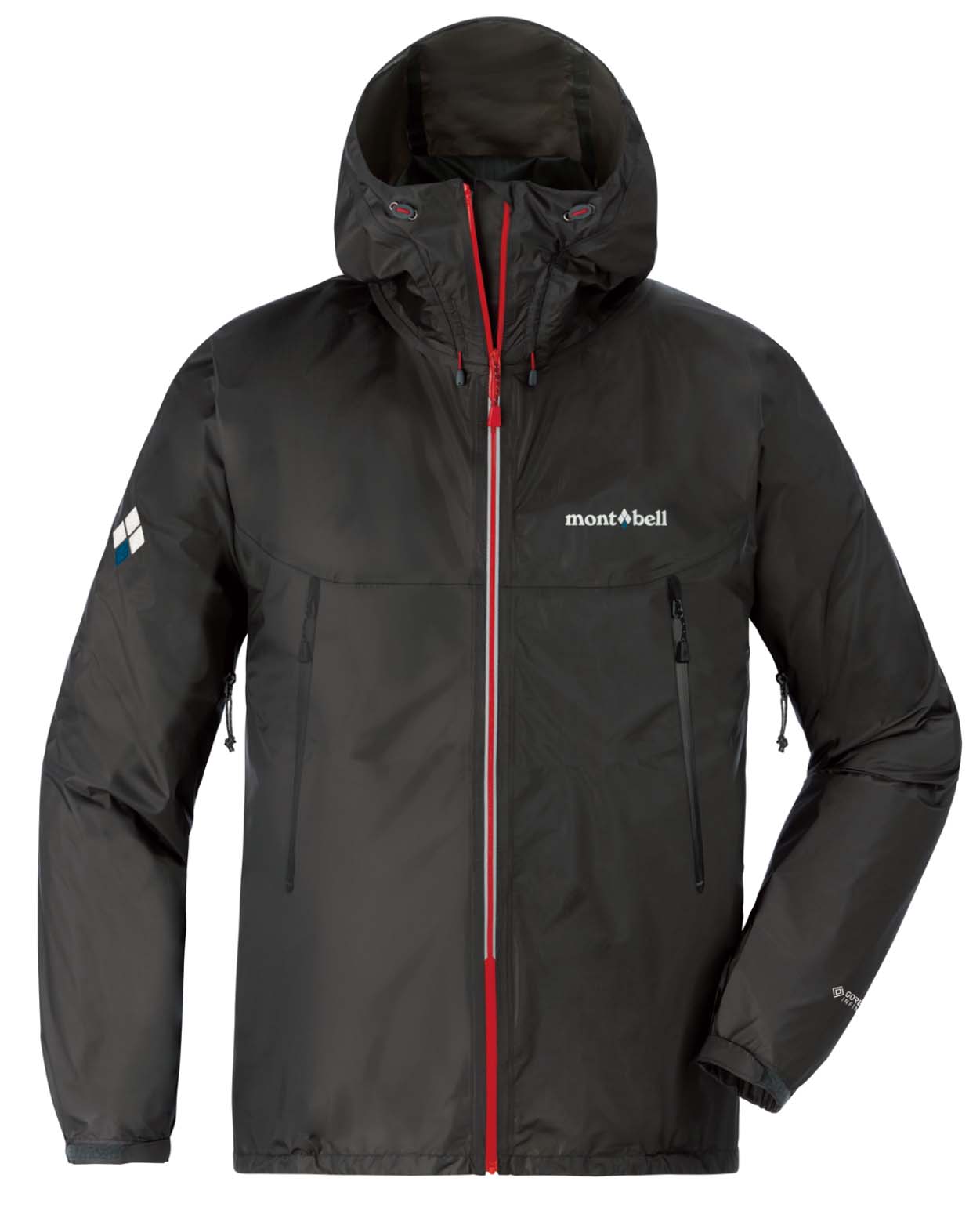 Category: Hiking
Category: Hiking
Weight: 6.4 oz.
Waterproofing: 2L Gore Windstopper
What we like: Great combination of weight and breathability.
What we don’t: Compromises in protection and durability, and it’s not an around-town piece.
The climbing community loves Montbell and for good reason: The company offers well-thought-out technical pieces that come in cheaper than brands like Arc’teryx and Patagonia. Weighing just 6.4 ounces, their Versalite rain jacket is a prime example: You get impressive breathability, good comfort, and features like pit zips and hand pockets for around $250. It’s worth noting that the Gore Windstopper construction alone technically isn’t waterproof, but Montbell added a nylon ripstop face fabric, minimal seams plus seam taping, and a DWR coating, making this jacket well equipped for fending off moderate rainfall. And the upside to Gore Windstopper is excellent breathability for the weight, which makes the Versatile a great option for long days of hiking (it’s no coincidence that it’s a part of Montbell’s thru-hiking collection).
As with many Montbell products, where the Versalite comes up short is everyday wear. The jacket’s extremely thin 10-denier face fabric (for reference, the ultralight Outdoor Research Helium Rain above uses far tougher 30D) will require extra care to avoid tears and punctures. Moreover, the tall hand pockets and exposed zippers lack the refinement and sleek styling that you get from an Arc’teryx product. That said, the Versalite checks a lot of boxes from a performance standpoint and deserves consideration from ultralight backpackers and minimalist summer-time adventurers.
See the Men's Montbell Versalite See the Women's Montbell Versalite
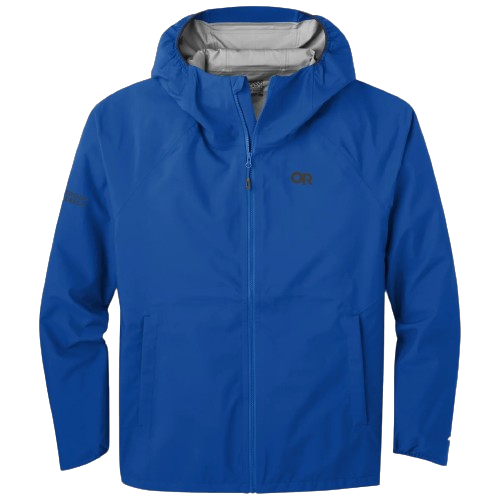 Category: Hiking/daily use
Category: Hiking/daily use
Weight: 10.9 oz.
Waterproofing: 3L AscentShell
What we like: Lightweight, breathable, and a good price.
What we don’t: Missing some useful features like wrist cinches and hipbelt-friendly pockets.
We’ve tested a number of Outdoor Research’s AscentShell models over the years, and the Motive is their lightest and most affordable to date. At just 10.9 ounces, it’s on par with many budget-oriented 2.5-layer designs like the Marmot PreCip Eco, yet the Motive features a 3-layer construction that easily beats out the Marmot in toughness and breathability. The interior is also quite comfortable for a rain shell, and we found it wasn’t prone to feeling clammy even when working up a sweat in Washington’s Hoh Rainforest. Reasonably priced at $229, the Motive has a whole lot going for it.
We’ve placed the latest AscentShell jacket toward the bottom of our list, however, because its finer details are somewhat disappointing. To start, the cuffs sit awkwardly around your hands: They’re too loose to create a good seal and would benefit from a Velcro cinch. In addition, the single side waist adjuster means the jacket feels uneven when pulled tight. And for a shell that’s intended for hiking and backpacking, we’d prefer the hand pockets sit a little higher to be accessible when wearing a hipbelt (the interior chest pocket is generously sized, however). For casual wear, these complaints may not be dealbreakers, but we think there are better crossover everyday/backcountry options.
See the Men's Outdoor Research Motive See the Women's OR Motive
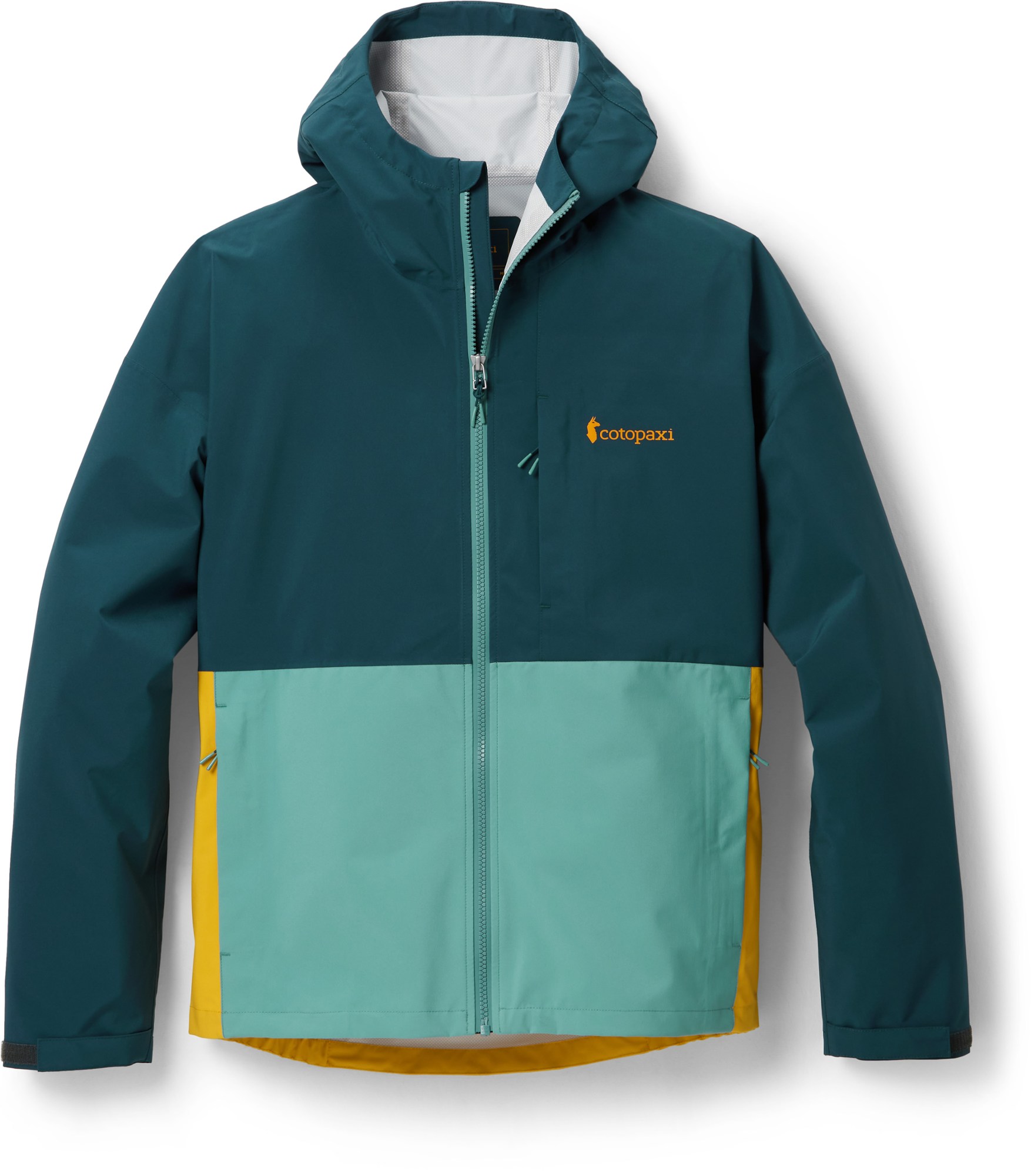 Category: Daily use
Category: Daily use
Weight: 1 lb.
Waterproofing: 2.5L
What we like: Fun styling and sustainable materials.
What we don’t: Heavy, won't hold up to downpours, and more expensive than other budget designs.
Based in Salt Lake City, Cotopaxi is a relatively new brand that has quickly risen to popularity in the outdoor world, thanks to their sustainable business practices, positive community presence, and—of course—hard-to-miss colorways. Their Cielo is a case in point: The rain jacket is built with a 100%-recycled shell with PFC-free DWR finish, and its vibrant color blocking and classy fit and finish make it fun to wear both on the trail and around town. What’s more, the feature set is on par with what we look for in an everyday rain jacket, including taped seams, Velcro cuffs, a hem adjustment, three pockets (two hand and one chest), and a water-resistant front zip. As with most of their offerings, Cotopaxi did something a little different with the Cielo, and we really like the result.
The Cielo will get the job done in light rain, but in the end it’s one of the least capable jackets here. Cotopaxi gives it a 10K waterproof rating, which generally correlates to only light protection against moisture. This compromised performance makes the $145 price tag a bit hard to swallow, especially when you can get better reliability for less with designs like the REI Rainier or Marmot PreCip Eco above (both of which are also lighter). But we do appreciate Cotopaxi’s effort towards sustainably built outerwear, and their rain jacket is undeniably good-looking for a budget piece. If you’re in the market for a casual shell for light drizzles or quick dashes between the car and the climbing gym, the Cielo fits the part.
See the Men's Cotopaxi Cielo See the Women's Cotopaxi Cielo
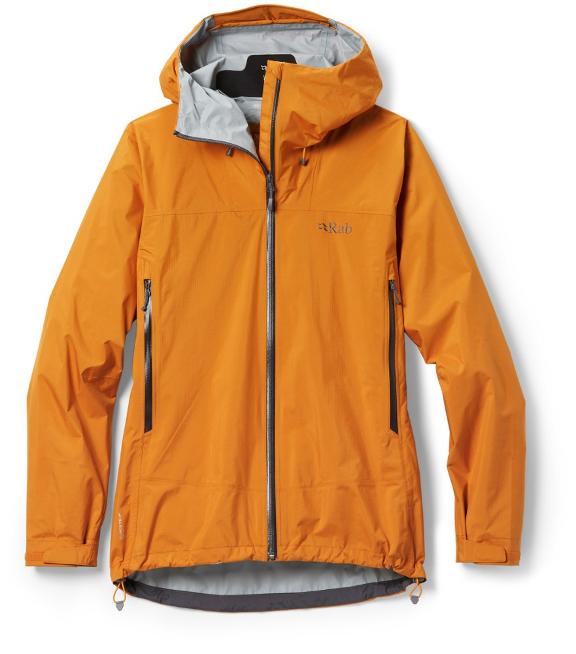 Category: Hiking/performance
Category: Hiking/performance
Weight: 13.2 oz.
Waterproofing: 2.5L Pertex Shield
What we like: Premium look and feel for under $200; semi-trim cut is great for active use.
What we don’t: Disappointing performance in heavy rain.
Rab is best known for their technical hardshells and insulated jackets—they’re a climbing company at their core—but they’ve been making consistent strides in the rain jacket market of late. Our favorite from their collection is the Downpour Plus 2.0, which offers a strong dose of performance at a very reasonable price point. The 2.5-layer shell is softer and more pliable than most 3-layer designs here, and all the touch points have a quality look and feel to them. The jacket also has great technical chops with pit zips; raised hand pockets that are hipbelt-friendly; and an adjustable, helmet-compatible hood. Overall, it’s a versatile design that should be on the radar for everyone from hikers and backpackers to bike commuters.
At $180, the Rab slides in between popular rain shells like the Patagonia Torrentshell and Marmot Minimalist above. All three jackets check in around 13 to 14 ounces and come with pit zips, but the Rab stands out with its smooth-operating coated zippers (the aforementioned jackets instead feature storm flaps) and trimmer fit. But we rank the Rab below the Patagonia and Marmot because of its subpar performance in heavy rain: The DWR coating wets out pretty quickly in a downpour, and the thinner shell fabric is prone to absorbing moisture and pressing against your arms and shoulders. As such, we think the Torrentshell and Minimalist are the better buys for those getting out in rough conditions. But if you prioritize comfort, a performance fit, and price, the Rab is at least worth considering.
See the Men's Rab Downpour Plus 2.0 See the Women's Rab Downpour Plus 2.0
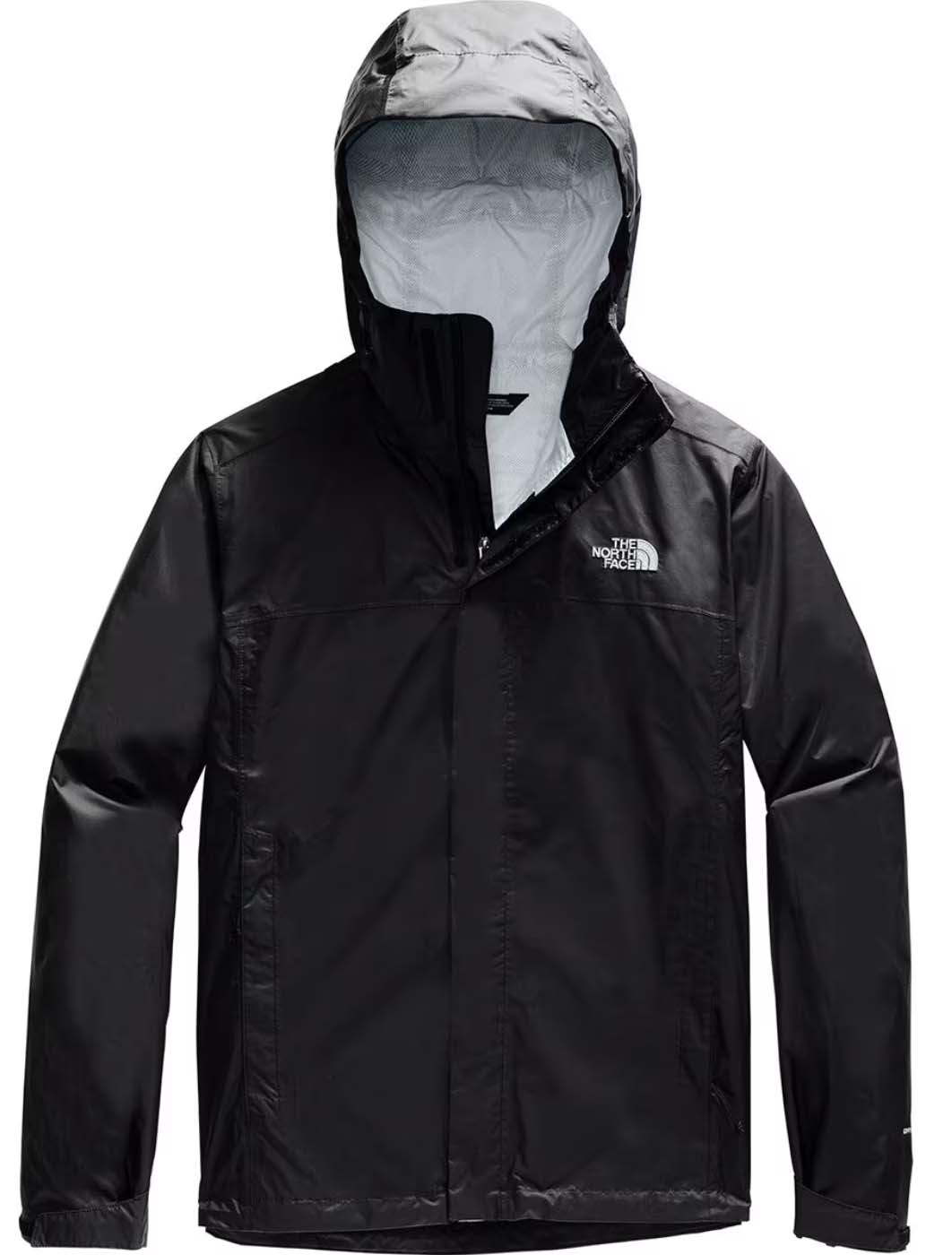 Category: Daily use/hiking
Category: Daily use/hiking
Weight: 11.6 oz.
Waterproofing: 2.5L DryVent
What we like: Another versatile rain jacket for about $100.
What we don’t: Falls a little short in hood design and zipper quality.
Just about every major outdoor brand offers a budget-oriented rain shell for about $100, and The North Face’s entry is the popular Venture. Like the Marmot PreCip Eco and REI Co-op Rainier above, the TNF features a 2.5-layer construction (in this case, their in-house DryVent design), pit zips for ventilation, and an adjustable hood. In addition, they’ve covered the basics for mixed daily wear and hiking uses with a reasonable 11.6-ounce weight, stuff pocket, and layering-friendly fit. Offered in a wide range of colors and backed by the brand’s impressive warranty, the Venture 2 is worth having on your radar.
Why do we have The North Face Venture 2 ranked here? To start, it has our least favorite hood design among its competitors with less coverage at the top of the head due to its flimsy bill. Second, the main zipper has a coil design that lacks the smooth, confidence-inspiring action of the Marmot and REI. Finally, we've had consistent issues with the jacket wetting out fairly quickly in heavy rainfall (it's also slow to dry). Despite our complaints, the Venture 2 is still a serviceable emergency shell and a step in the right direction from the old Venture, which we found to be very cheaply made. For a similar concept but with a more durable, around-town-friendly build, check out TNF’s Resolve 2... Read in-depth review
See the Men's The North Face Venture 2 See the Women's The North Face Venture 2
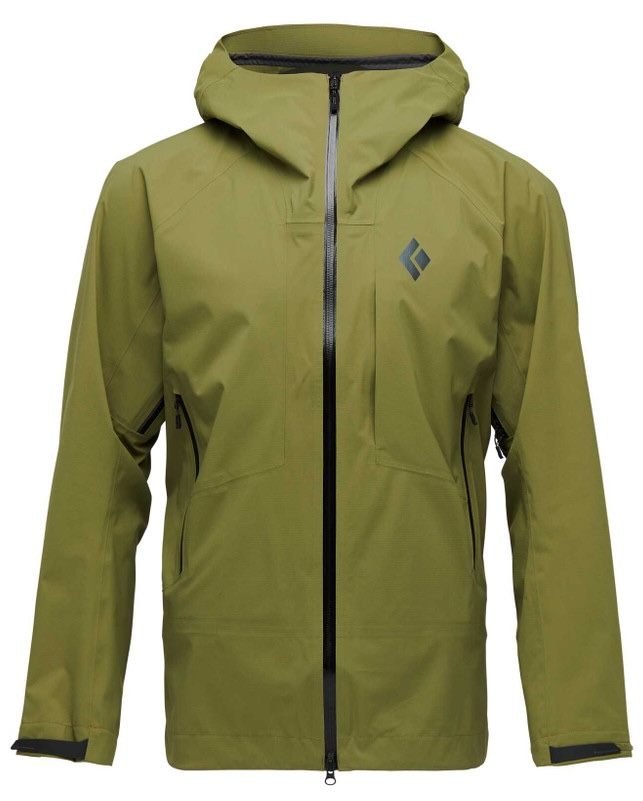 Category: Performance
Category: Performance
Weight: 12.7 oz.
Waterproofing: 3L BD.dry
What we like: A stretchy and light performance shell.
What we don’t: Less bombproof and versatile than a Gore-Tex design; no longer a good value.
Building on the success of the StormLine above, Black Diamond took that expertise upmarket with the Highline Stretch. Here’s the story: This hardshell-like design includes a 3-layer variation of their in-house BD.dry membrane, has a light amount of stretch incorporated into the nylon build, and keeps things pretty light at 12.7 ounces (our men’s medium is slightly more at 12.8 oz.). The Highline sticks to BD’s roots with a climbing helmet-compatible hood (though it’s too small for a standard ski helmet) and includes useful features like pit zips, hand pockets, and a tall collar. For fast-and-light alpine trips when the forecast looks favorable, the Highline certainly can do the trick.
Overall, we think BD’s Highline does a nice job balancing weight and performance for 3-season use, but it can’t compete with the Gore-Tex-equipped Beta LT above in terms of outright protection and refinement. While a recent update improved overall durability, the Highline’s construction and components still aren’t as confidence-inspiring as the Arc’teryx’s, and BD’s $100 price increase now puts the $450 Beta LT within spitting distance. In our opinion, the Arc'teryx is definitely worth the upgrade if you’re looking for a year-round piece, but if you don’t need full-on winter protection, the Highline is a comfortable and well-designed shell for a little less... Read in-depth review
See the Men's BD Highline Stretch See the Women's BD Highline Stretch
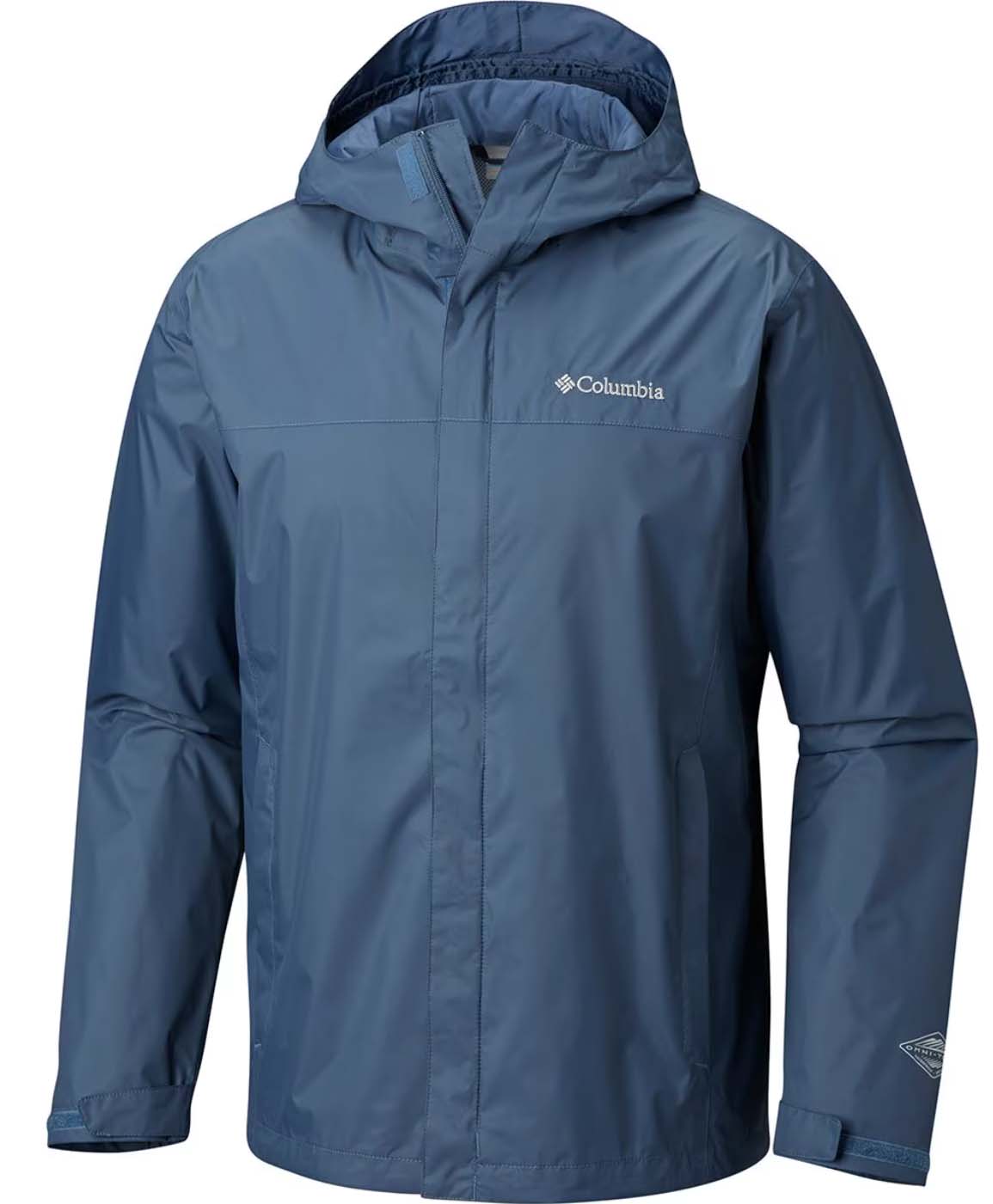 Category: Daily use
Category: Daily use
Weight: 13 oz.
Waterproofing: 2L Omni-Tech
What we like: Great value and lots of color options.
What we don’t: Cheap construction has a plasticky feel.
Priced at $75 and often available for a discount at Amazon, the Columbia Watertight II is a leading budget rain jacket. And while it doesn’t stack up as well in performance testing, good seam sealing and a reliable build make it a solid option for daily use or as a just-in-case shell when bad weather isn’t in the forecast. The Portland-based brand does value-oriented gear better than most, and the Watertight and women’s-specific Arcadia include a number of features you don’t often find at this price point: zippered hand pockets, Velcro wrist cinches, and an adjustable hood.
How does the Watertight II compare with REI’s budget-friendly Rainier above? Both jackets have large fits (sizing down is recommended unless you want room for layering), stuff away into a pocket, and weigh about the same (the REI 1.7 oz. lighter). The Columbia will save you around $25, but the Rainier's 2.5-layer design is more breathable, and the shell and interior are noticeably softer to the touch. You also get pit zips for dumping heat and a higher-quality hood with better adjustability, which are worthwhile upgrades for most hikers. In other words, unless you prioritize price above all else, we think the REI is the better buy... Read in-depth review
See the Men's Columbia Watertight II See the Women's Columbia Arcadia II
| Jacket | Price | Category | Weight | Waterproof | Pit Zips | Packable |
|---|---|---|---|---|---|---|
| Patagonia Torrentshell 3L | $179 | Daily use/hiking | 14.1 oz. | 3L H2No | Yes | Yes |
| REI Co-op Rainier | $100 | Daily use/hiking | 11.3 oz. | 2.5L HydroWall | Yes | Yes |
| Arc'teryx Beta LT | $450 | Performance/hiking | 13.9 oz. | 3L Gore-Tex | Yes | No |
| Black Diamond StormLine | $180 | Hiking/daily use | 11.3 oz. | 2.5L BD.dry | Yes | Yes |
| Outdoor Research Helium Rain | $170 | Hiking | 6.2 oz. | 2.5L Pertex | No | Yes |
| Outdoor Research Foray II GTX | $225 | Hiking/performance | 11 oz. | 2L Gore-Tex | Yes | Yes |
| Norrøna Falketind Paclite | $349 | Performance | 9.1 oz. | 2.5L Gore-Tex | No (Core) | Yes |
| Marmot PreCip Eco | $120 | Daily use/hiking | 11 oz. | 2.5L NanoPro | Yes | Yes |
| Arc’teryx Beta | $400 | Hiking/performance | 13.2 oz. | 3L Gore-Tex | No | No |
| Marmot Minimalist | $220 | Daily use/hiking | 13 oz. | 2.5L Gore-Tex | Yes | No |
| Montbell Versalite | $260 | Hiking | 6.4 oz. | 2L Infinium | Yes | Yes |
| Outdoor Research Motive | $229 | Hiking/daily use | 10.9 oz. | 3L AscentShell | No | Yes |
| Cotopaxi Cielo | $145 | Daily use | 1 lb. | 2.5L | No | No |
| Rab Downpour Plus 2.0 | $180 | Hiking/performance | 13.2 oz. | 2.5L Pertex | Yes | Yes |
| The North Face Venture 2 | $110 | Daily use/hiking | 11.6 oz. | 2.5L Dryvent | Yes | Yes |
| Black Diamond Highline Stretch | $400 | Performance | 12.7 oz. | 3L BD.dry | Yes | Yes |
| Columbia Watertight II | $75 | Daily use | 13 oz. | 2L Omni-Tech | No | Yes |
Editor's note: "Packable" indicates the jacket has a stuff pocket.
Our rabble of rugged adventurers at Switchback Travel is no stranger to long days in the mountains blasted by incessant rain. From soaking-wet forests in the Pacific Northwest to driving storms on lofty peaks in Patagonia, we've taken our rain jackets on some wild adventures and allow only the best to wiggle their way into this round-up. Former editor-in-chief John Ellings put together our initial selection of 10 worthy jackets back in 2015, pulling from years of extensive experience on far-flung expeditions and local tours in the damp Cascades to weed through the masses. Senior editor Chris Carter took over the guide in 2024. A seasoned thru-hiker and rock climber, Chris is intimately familiar with the importance of a dependable rain shell for safety and comfort in the backcountry.
Our current list of 17 rain jackets represents the crème de la crème of these hardy shells. To truly test the mettle of each model, we take them on rigorous, real-world adventures, gauging their ability to keep us dry and protected in wet environments. We focus on key features like durability, packability, and breathability to help decide which jackets are best suited for technical performance use or more casual, daily wear. We know that not every outdoor mission is the same, which is why we included a relatively broad variety. As the competition evolves and changes, we’ll keep our finger on the pulse of the rain jacket market, testing new models and technologies to continue updating the list above.
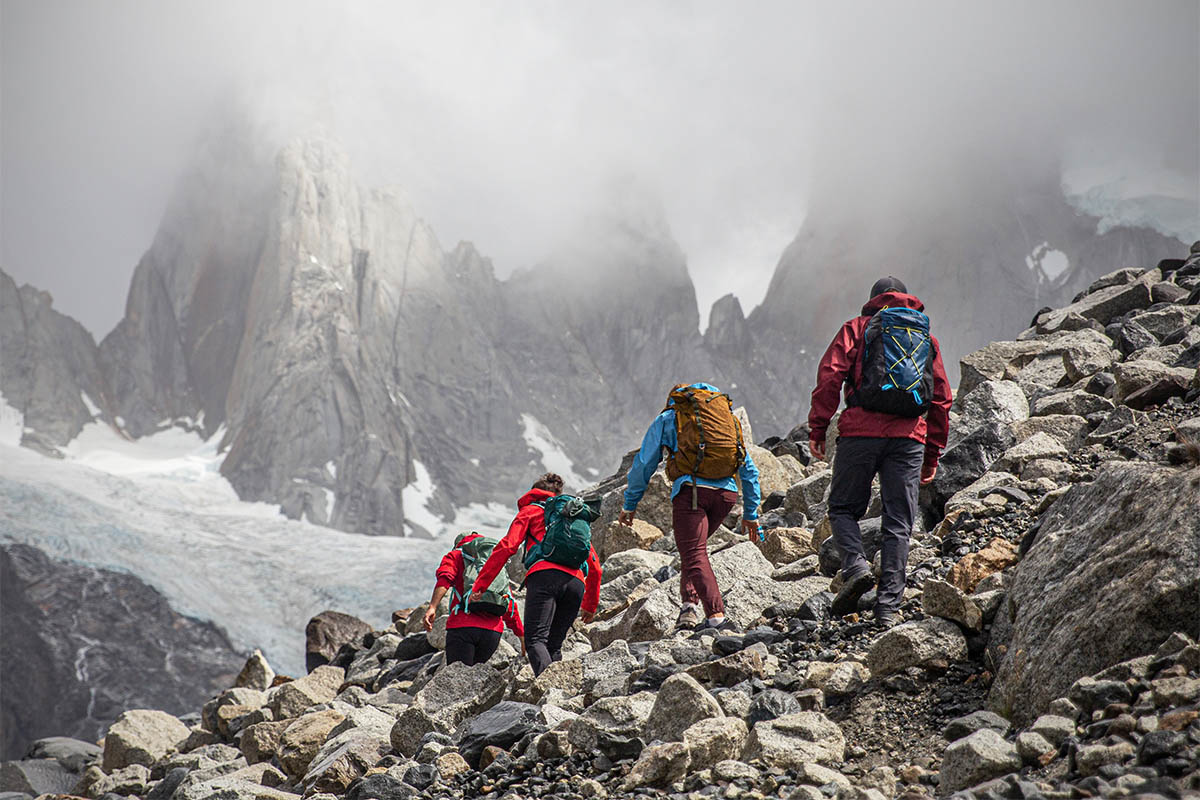
Daily Use
If you live in a wet climate like the Pacific Northwest or New England, a rain jacket is an indispensable part of your everyday wardrobe. For daily uses like commuting, running errands, or walking the dog, you’ll likely prioritize a casual fit (which will accommodate a wide variety of layers underneath) and useful features like handwarmer pockets and Velcro wrist cinches. You won’t often see add-ons like helmet-compatible hoods or exposed, water-resistant zippers in this category, and daily use jackets don’t prioritize weight-savings or packability (in fact, they’re often quite thick and durable). As a result, daily use jackets are either budget-oriented or designed with style in mind, and some of our favorites include the Patagonia Torrentshell 3L (which crosses over nicely into the hiking category below) and Marmot Minimalist.
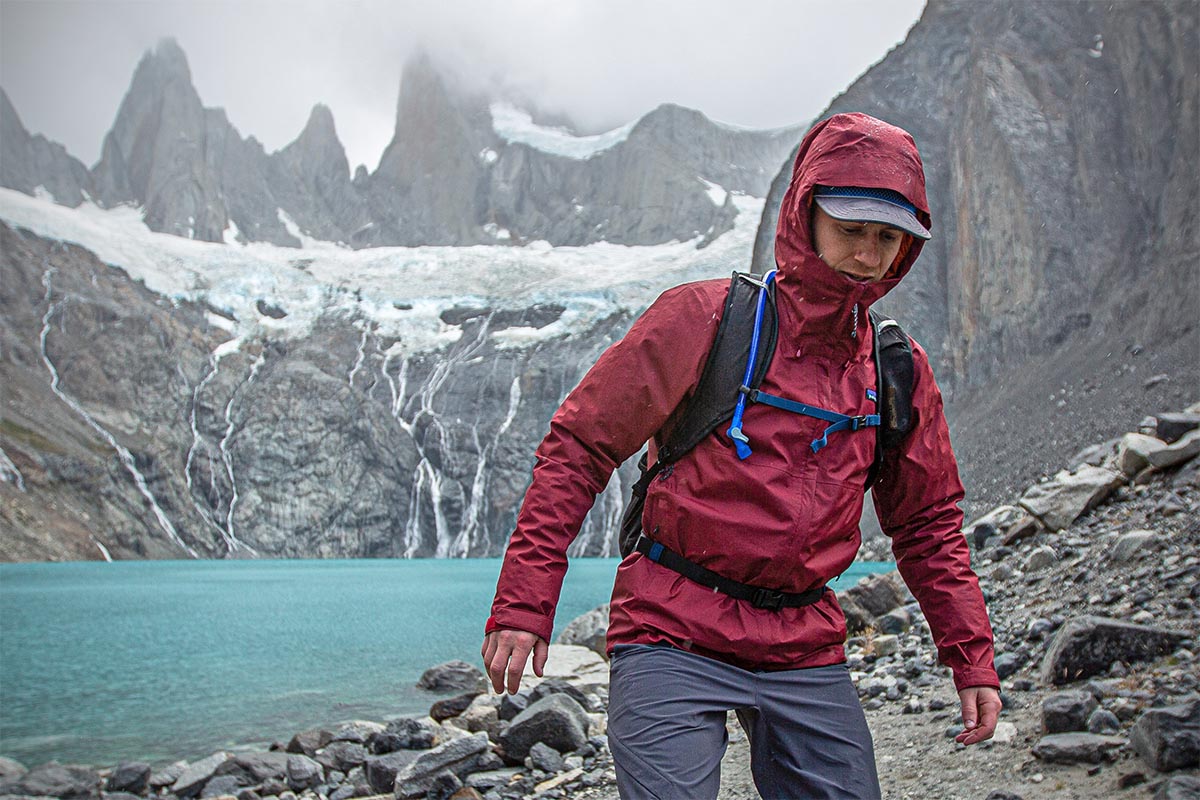
Hiking
Hiking-focused shells vie with those in our daily use category for the most common type of lightweight rain jacket. This designation includes big sellers like the entry-level Marmot PreCip Eco all the way up to the $400 Arc’teryx Beta. Hiking jackets are built to be light and packable to bring along on a backcountry trip, and their performance in heavy rain and wind is admirable—particularly the more substantial Gore-Tex Paclite models (including the Marmot Minimalist and Outdoor Research Foray II). Breathability does suffer compared with the performance shells below and the cheaper jackets won't last as long, but hiking shells are a nice middle ground of price, weight, and protection.
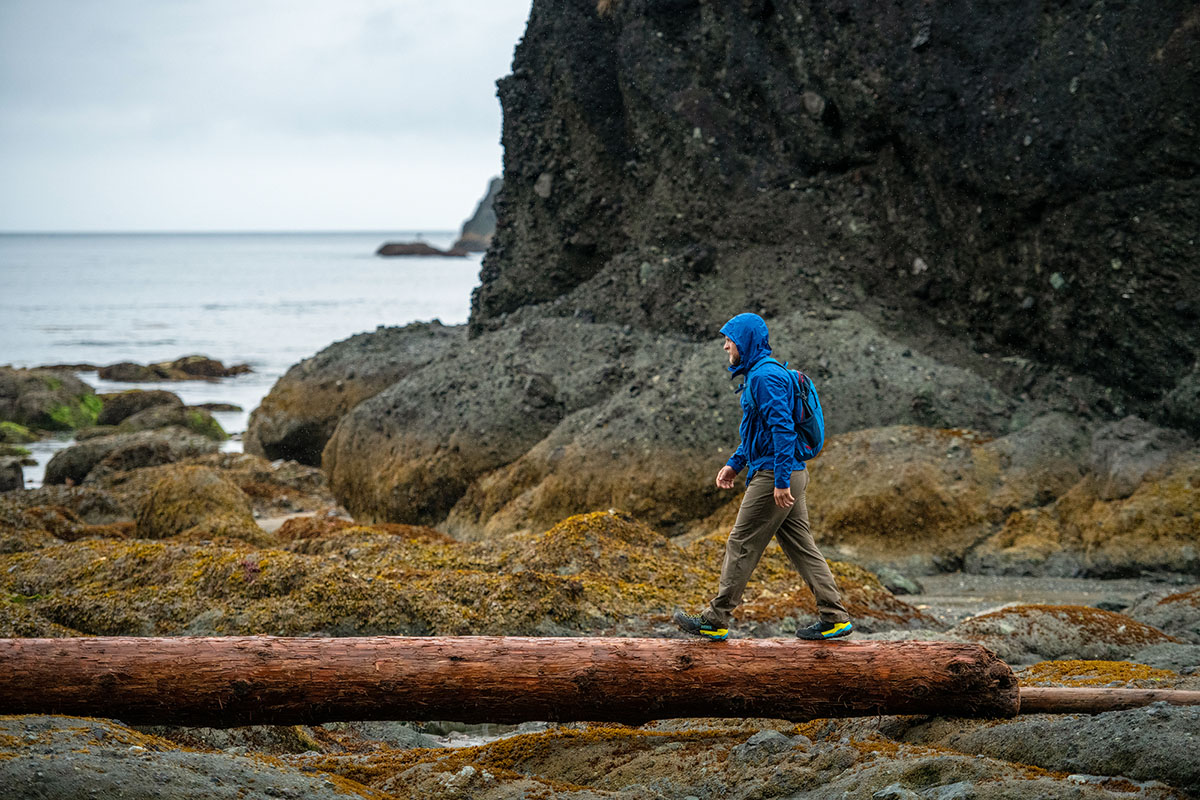
Performance
Performance-oriented rain jackets are your focused outdoor pieces. One step down from a full-on hardshell jacket, they're made to withstand extreme conditions: The shell fabrics are tougher, the waterproof membranes are better breathers, and the hoods are more substantial. As a result, the interior fabrics are also much less prone to clamming up, and often have a premium, soft feel. Price does increase with these upgrades, although daily usability is nearly on par with the hiking/daily use category above. The primary compromise is pocket placement as some hand pockets sit high to accommodate a climbing harness or backpack hipbelt. Jackets in this category include the Arc'teryx Beta LT, which impressed us with its performance during a wet and slushy winter in the PNW.
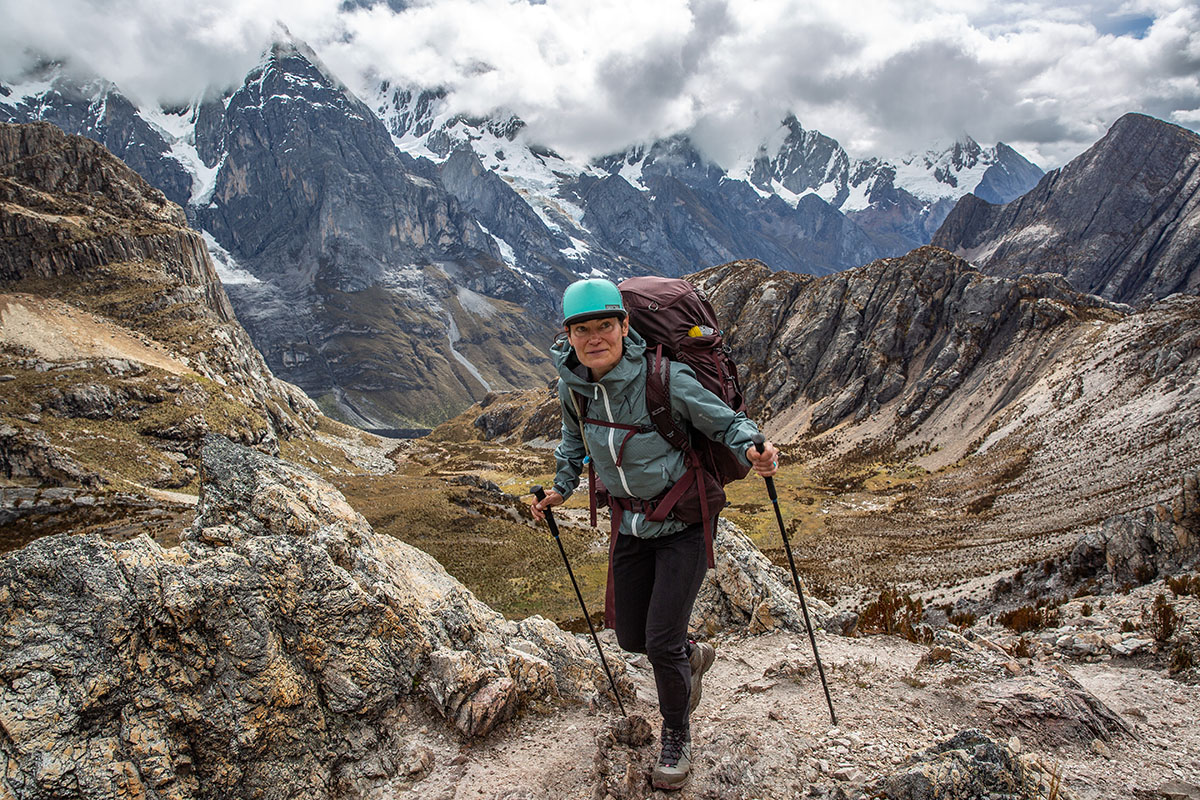
No piece of outdoor gear offers total protection from outside moisture, but most of today’s rain jackets are listed as being either “water-resistant” or “waterproof.” Many light rain jackets, windbreakers, and softshells are water-resistant, meaning that they shed water in light to modest precipitation but aren’t completely waterproof under extended exposure. These jackets are often more breathable than their fully waterproof counterparts but won't hold up to perpetual downpours. Instead, they shine on fast-and-light missions where efficiency, ventilation, and weight are of utmost concern. Waterproof jackets have a built-in laminate layer (like Gore-Tex) or a coating that essentially blocks outside moisture from entering under most conditions. Additionally, they have waterproof taping along the seams on the interior of the jacket.
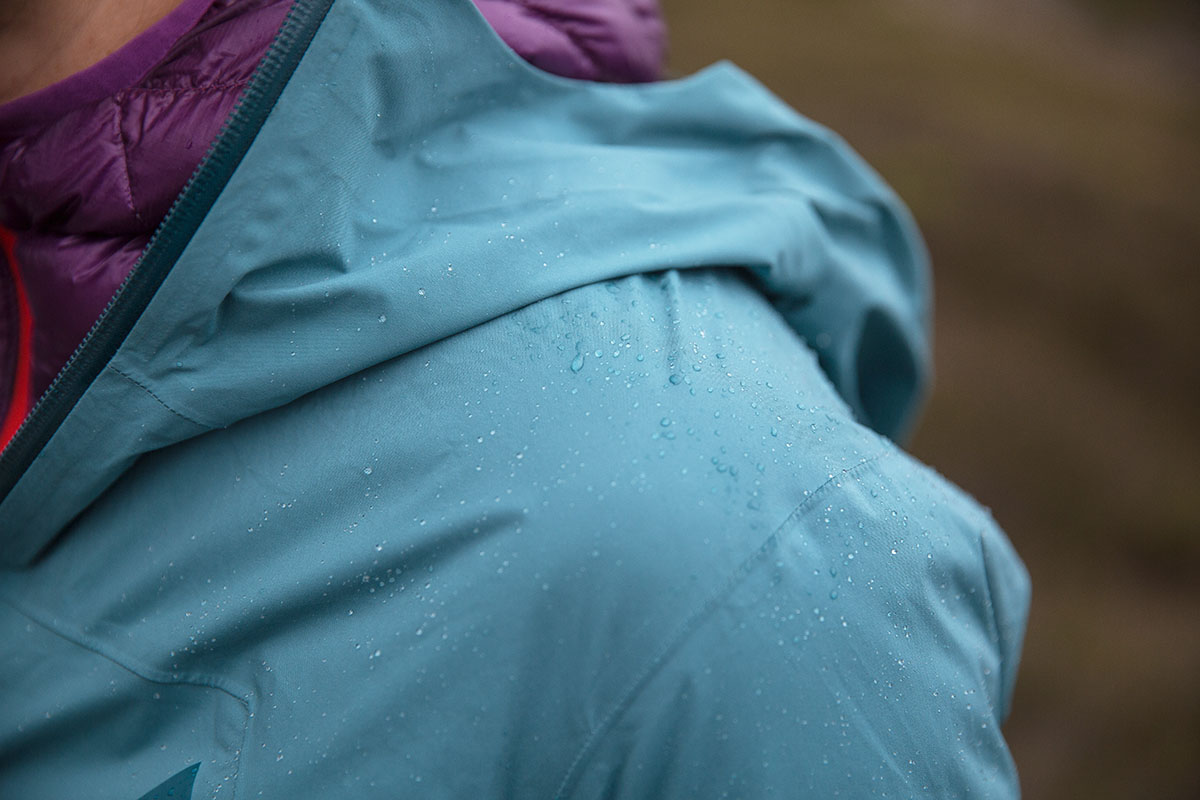
You may notice a waterproof rating listed on some outdoor gear websites, represented by a number from 0 to 20,000mm or more. This is the amount of water in a 1-inch-diameter vertical tube that the material can withstand without leaking. The test is a strange one: It doesn’t mimic real-world conditions and many manufacturers choose not to list it at all. Other factors like seam taping play a major role in waterproofness, so the number doesn’t truly determine how dry you will stay in a downpour. We at Switchback Travel don’t feel the waterproof ratings are very helpful in the buying process and have chosen not to list them with our specs. You can take note of the number when it’s available, as it will often correlate with other characteristics like fabric thickness and durability, but don’t base your buying decision on that alone.
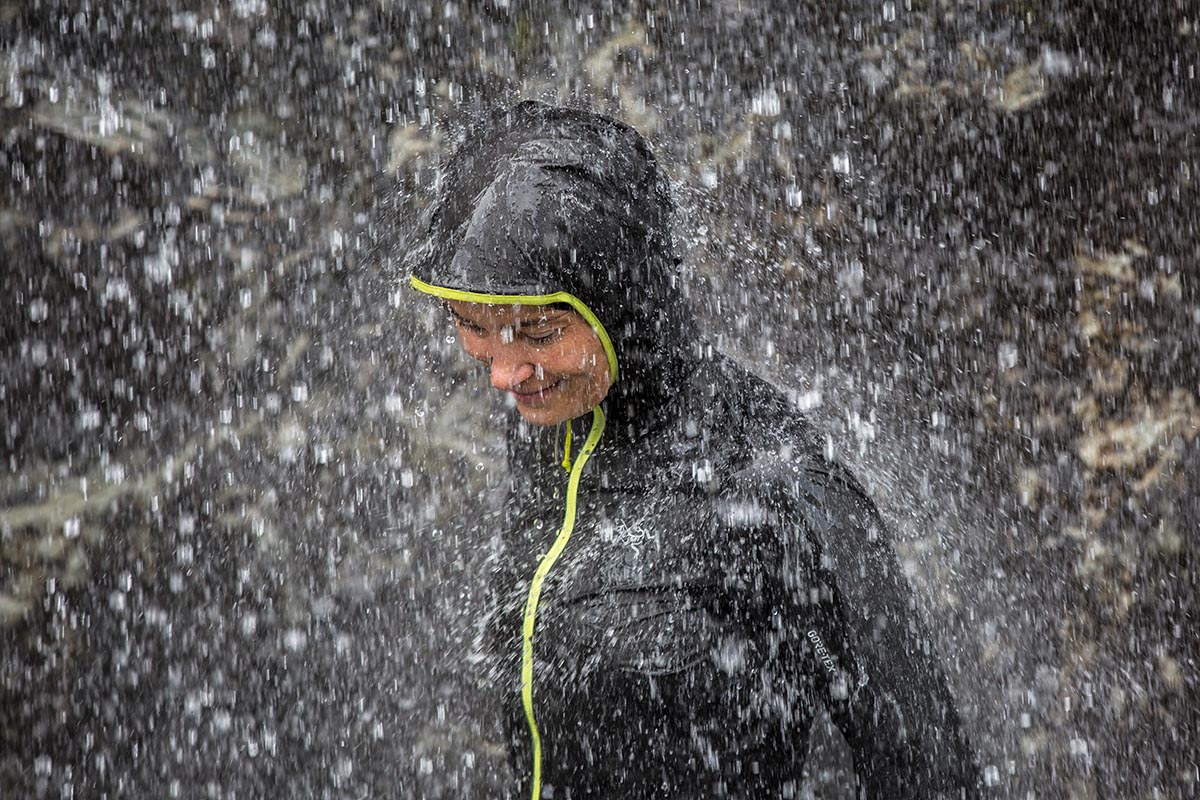
To create a waterproof rain jacket that resists moisture from entering yet also lets sweat and hot air vent out requires a combination of fabric layers. You’ll see this referenced in every performance-oriented rain jacket on the market, typically seen as: 2L, 2.5L or 3L. We break down the pros and cons of each below, and for a deep dive, check out our article on rain jacket construction.
2-Layer
These jackets are the most basic, and typically require a mesh liner to protect the jacket’s inner coating (hence the 2-layer name). They’re not very breathable and the mesh adds bulk, making 2-layer jackets best for casual use. You’ll often find them in entry-level styles, such as the $75 Columbia Watertight II above. One notable exception is a jacket like the Norrøna Falketind Gore-Tex Paclite that uses Gore-Tex’s Paclite Plus, which has a minimalist, protective treatment on the interior in place of a hanging liner to minimize weight and bulk. The treatment is thinner than the sprayed-on coating of a 2.5-layer jacket (more on this below), so we consider the Falketind a 2-layer piece.
.jpg)
2.5-Layer
A 2.5-layer jacket attaches a very thin interior fabric to the waterproof/breathable laminate or coating. The benefit of this interior finish is that the mesh found in 2-layer jackets is no longer necessary. Breathability as well as compressibility increases and weight decreases with the design, making this the most popular option for hikers, backpackers, and climbers. One downside is that the interior fabric isn't as soft to the touch as a true 3-layer (some consider it slippery or plasticky), but we've seen improvements with recent models.
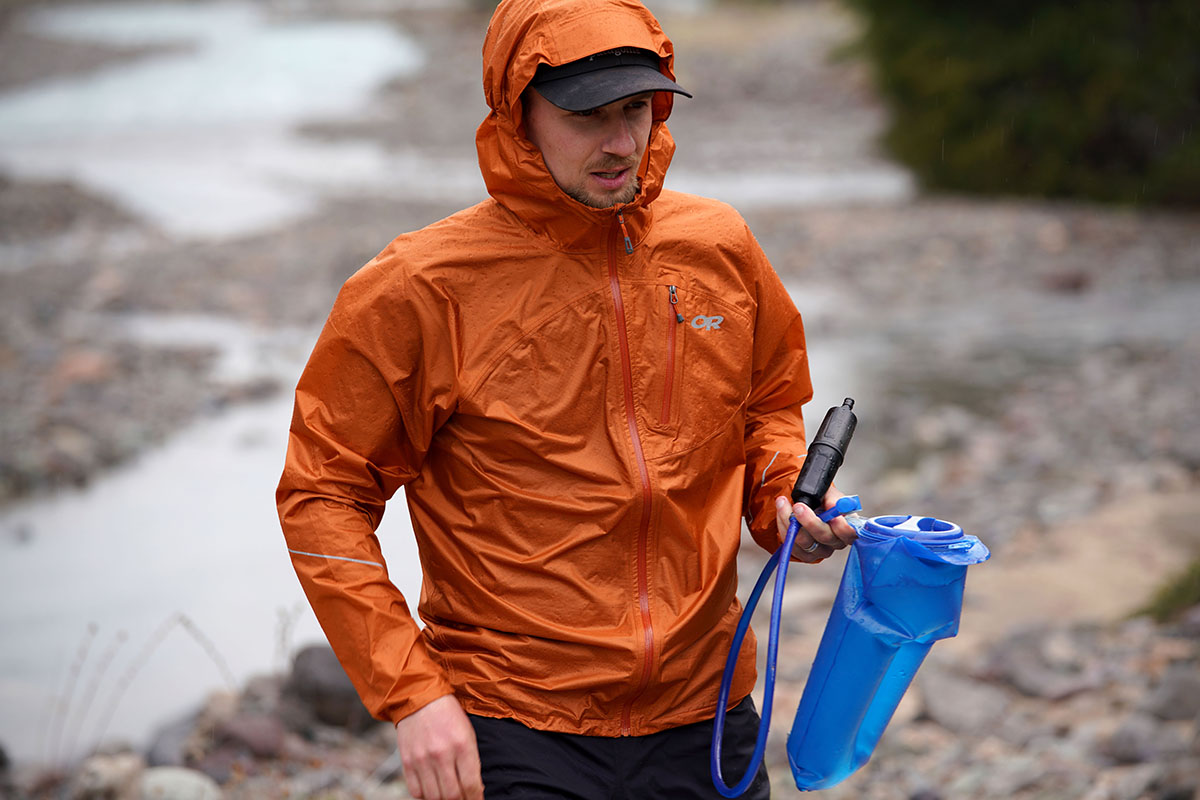
3-Layer
A true 3-layer construction incorporates three separate pieces of fabric, with the actual waterproof and breathable membrane in the middle and a more substantial fabric on the interior. This adds a bit of bulk than a comparable 2.5 layer, but increases durability and further improves moisture wicking and next-to-skin feel. Jumping to a 3-layer jacket also involves a significant increase in price (one exception is Patagonia's $179 Torrentshell 3L), and most often these are big name designs, like Gore-Tex or eVent. It's worth noting that nearly all premium performance jackets to make our list have a 3-layer construction.
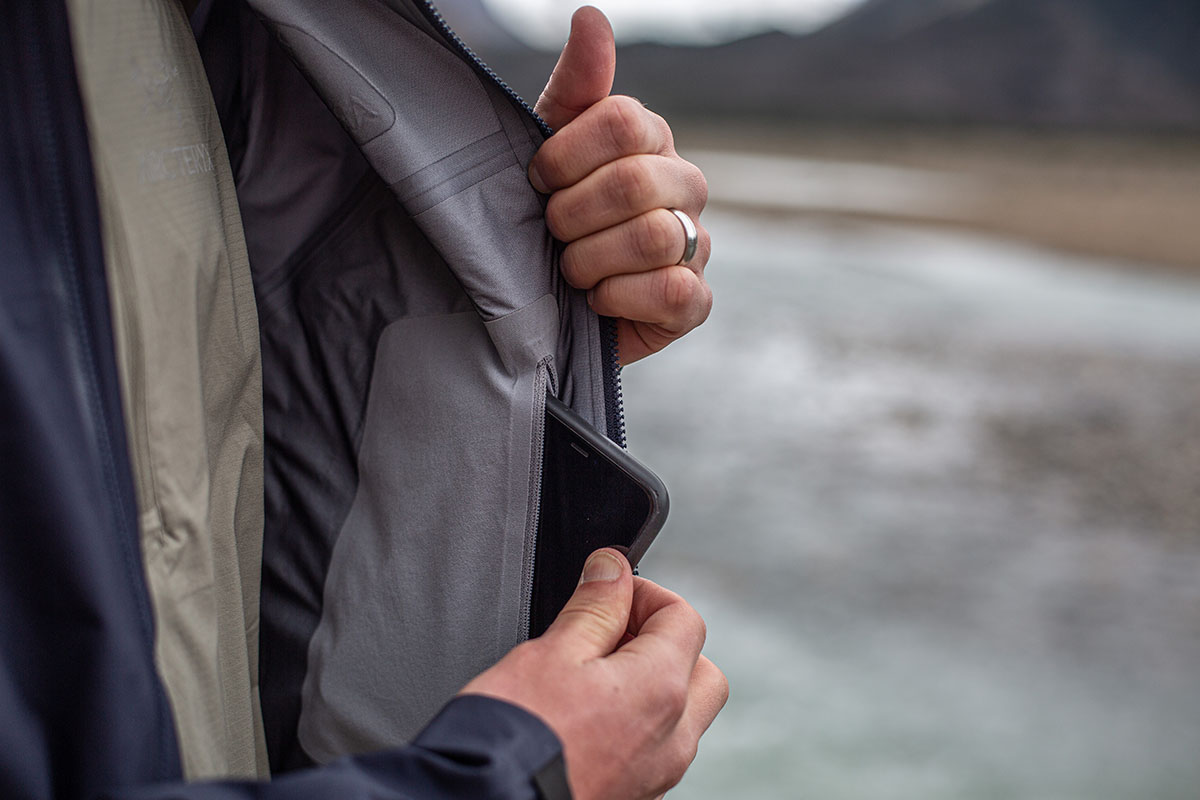
In addition to the waterproof membrane, another key piece of a rain jacket’s protection is its durable water repellent finish (commonly referred to as DWR). This coating is applied to the exterior of most rain jackets to prevent moisture from absorbing into the face fabric by beading up the droplets. A fresh DWR is an impressive thing and can offer excellent protection in light to moderate conditions, although heavy and sustained rainfall will eventually overwhelm the coating (that’s where the waterproof membrane comes into play). Over time, the DWR finish will wear down, although you can keep it fresh by staying on top of maintenance (more on this in our “Care” section below).
A final note related to DWR is that there has been a recent push to move away from traditional coatings that use perfluorocarbons, which is a chemical that has been linked to environmental and health issues. It’s still a developing technology and key brands like Patagonia haven’t made the full switch yet (for more, here’s Patagonia’s breakdown of the process), but PFC-free options are becoming more prevalent on the market. We outline other key measures in our "Sustainability" section below.
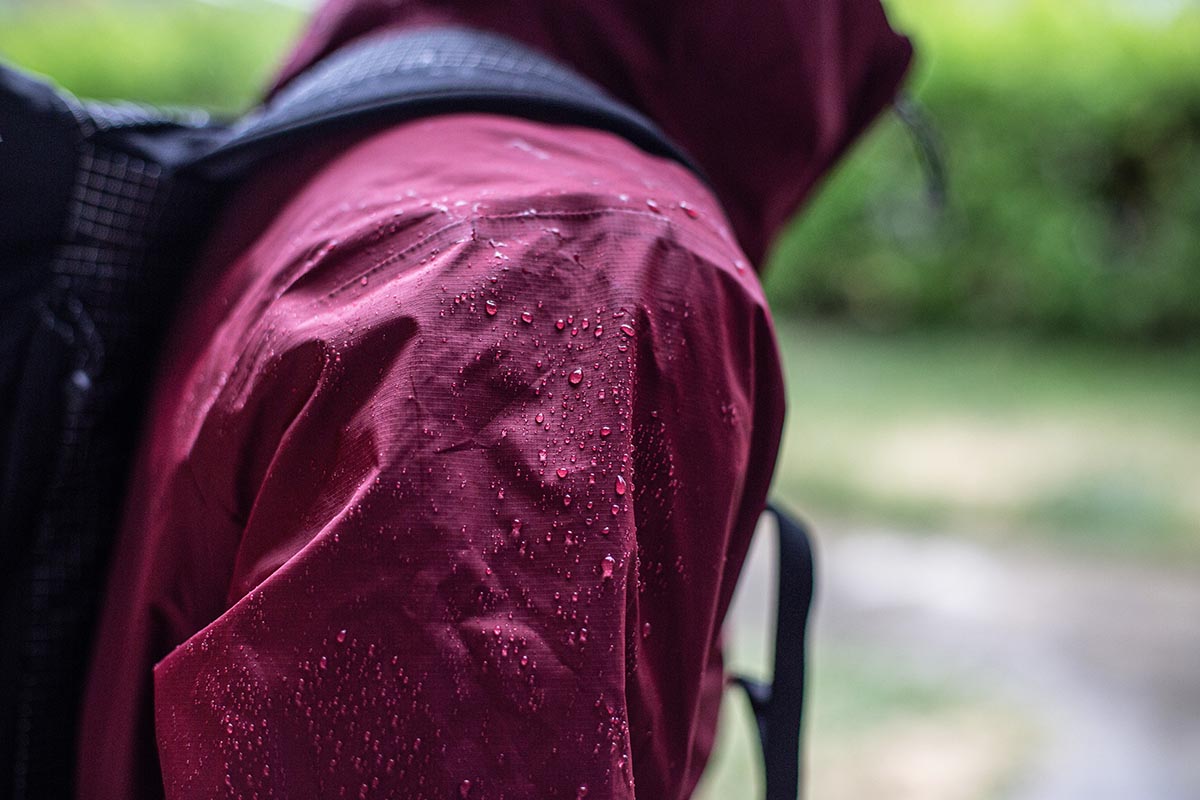
A quick look at our comparison table above reveals that rain jacket weights correlate closely with their intended use(s). On the lightweight end of the spectrum are hiking-ready shells like the Outdoor Research Foray and Motive AscentShell (11 and 10.9 oz., respectively), while designs that are more feature-rich and durable for crossing over for daily wear often add a bit of weight (including the 14.1-oz. Patagonia Torrentshell and 13.9-oz. Arc'teryx Beta LT). For those who want a well-rounded option, we’ve found the 9- to 16-ounce range is typically the sweet spot.
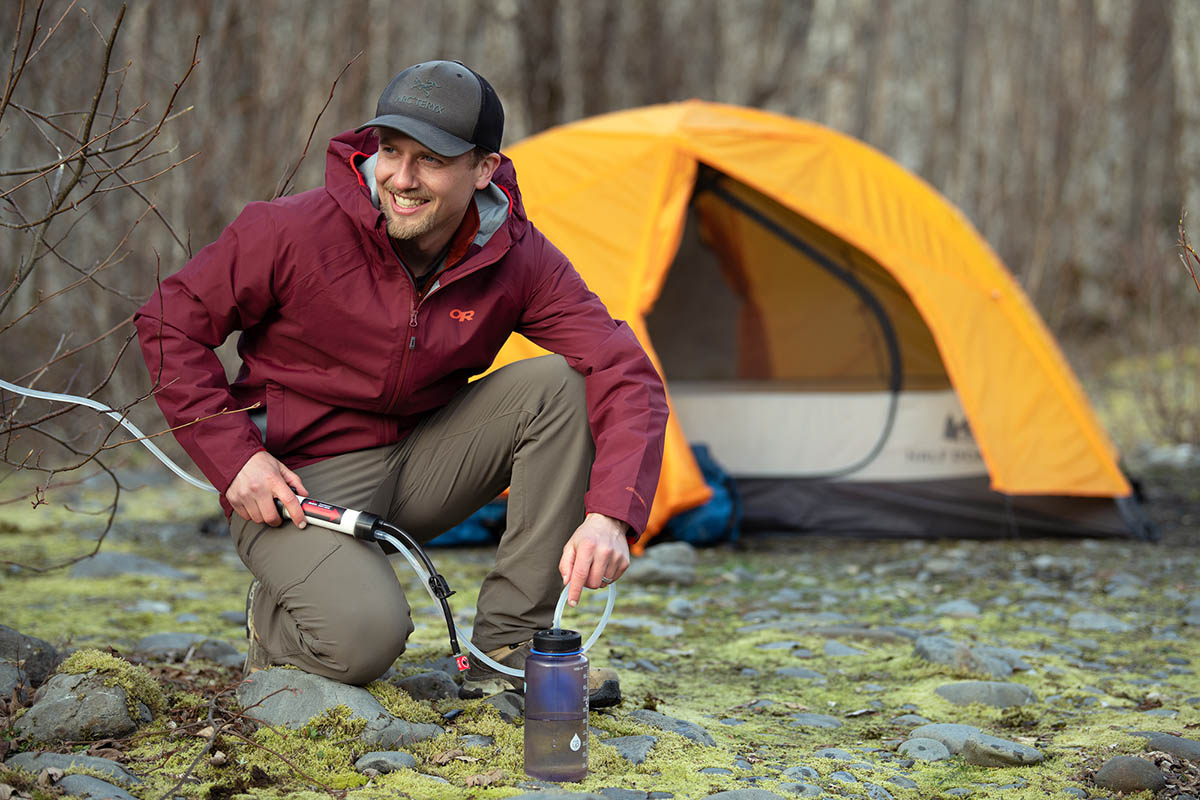
One of the most sought-after features in a waterproof rain jacket is breathability: the ability for perspiration and other moisture to exit the jacket without outside water coming in. Some cheaper rain jackets are barely breathable at all, but almost all of the fabrics used in today’s models are at least somewhat breathable and promoted as such. The market leader has long been Gore-Tex, particularly in their high-end "Active" and "Pro" offerings, but a number of fabrics are now challenging the paradigm, including AscentShell by Outdoor Research. Generally speaking, the more you spend the more breathable the jacket will be. One exception is ultralight jackets, which cost more than cheap lightweight models but ventilate approximately the same in most cases. A jacket’s ability to keep you cool is greatly enhanced with the inclusion of pit zips, which we discuss further below.
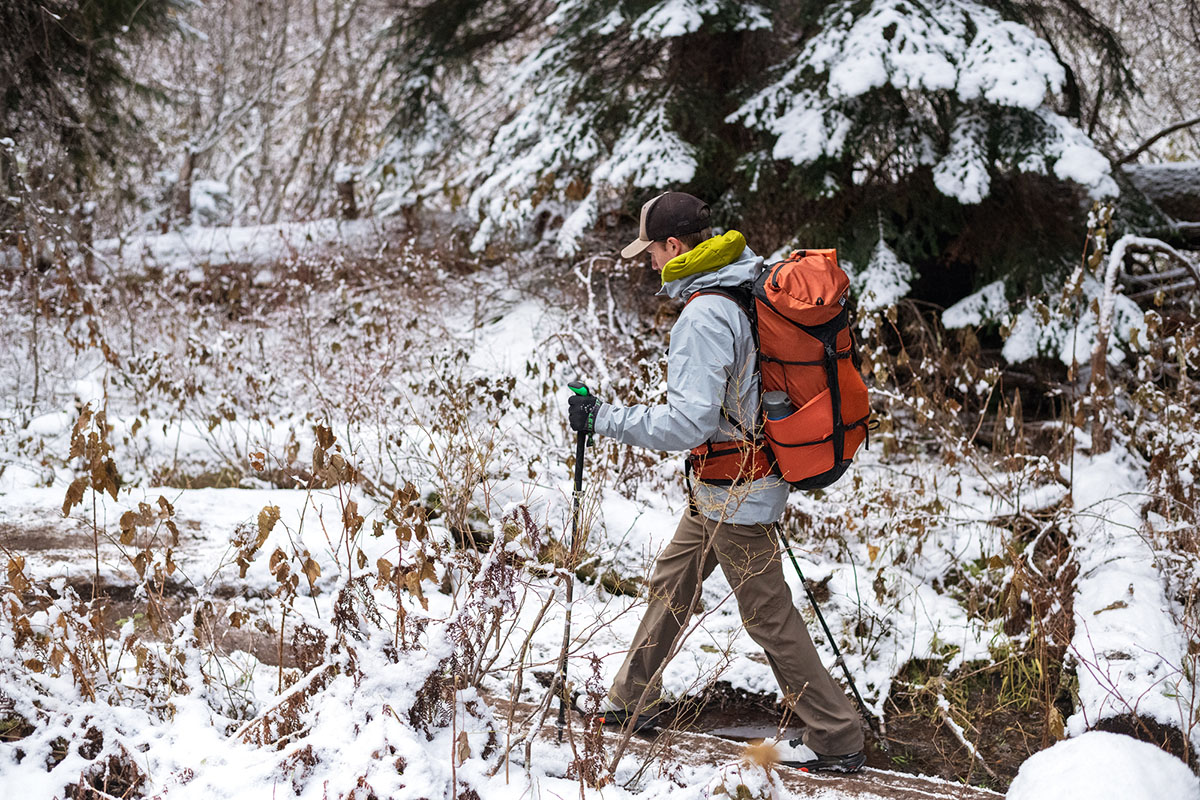
A jacket’s packability can be looked at and measured in a couple ways. First, there are the jackets that can stuff into their own pockets. Just turn the pocket inside out, smoosh the jacket in, and zip it shut. While this is great, it’s doesn’t necessarily mean the jacket is that packable. The packed sizes can vary widely for these “packable” shells, with the ultralights resembling a small envelope and others, like the cheaper Columbia Watertight, measuring about 3x the size. The other way of looking at packable rain shells is how compressible they truly are. In that respect, the lightweight Arc'teryx Beta would still be considered quite “packable," despite lacking a stuff pocket. You can just roll it up into its own hood to protect the thinner fabric in your pack. Look to weight as a great indicator of how packable a jacket truly is.
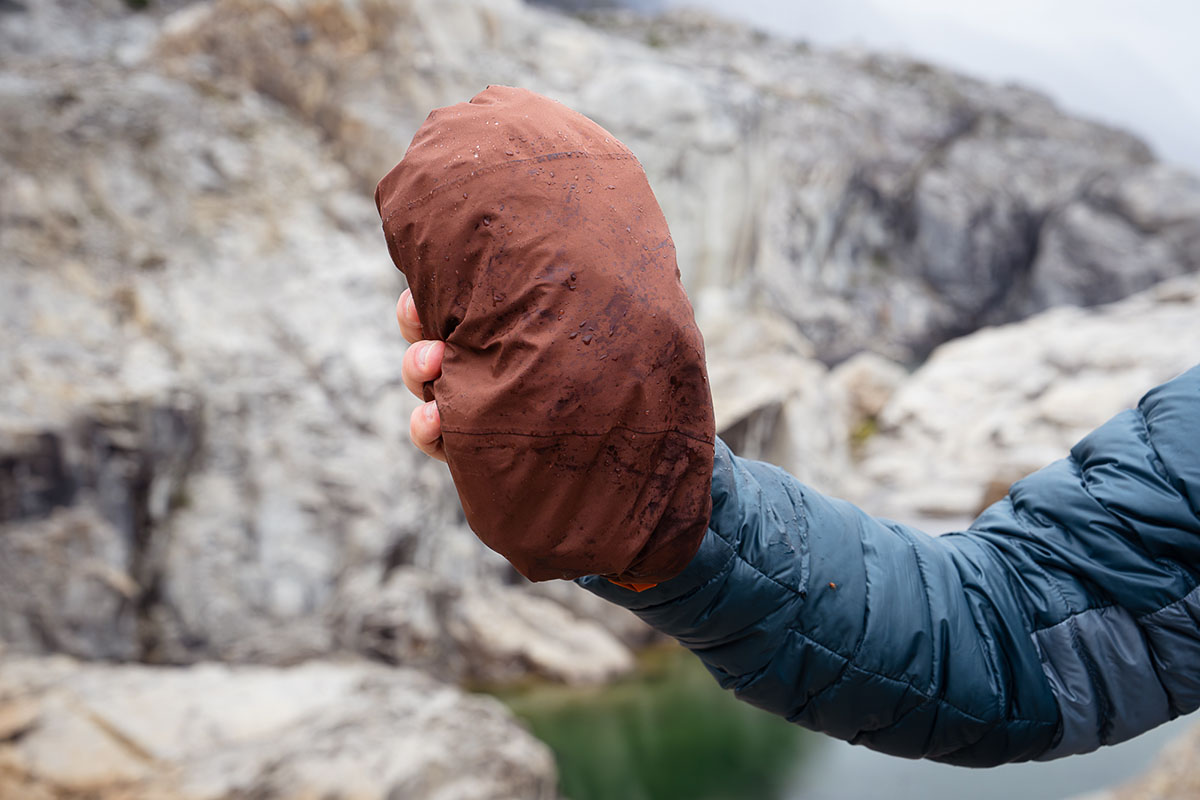
The outdoor apparel world has seen a sizable uptick in the use of sustainable practices over the past several years, and the rain jacket market has been one of the most dynamic. Key measures include recycled materials and PFC-free DWR coatings (traditional coatings use per- or polyfluorinated chemicals—"forever chemicals" known to be harmful to the environment). With many states stepping up to ban the sale of items that include PFCs, the outdoor industry is seeking better solutions for water- and stain-resistant finishes (for more, you can read about Patagonia’s take on the issue). Bluesign-approved fabrics are also becoming more common, indicating that the materials have been sourced and produced to minimize their overall impact on the environment. Finally, many companies make products with a Fair Trade certification, which helps ensure the fair and ethical treatment of workers.
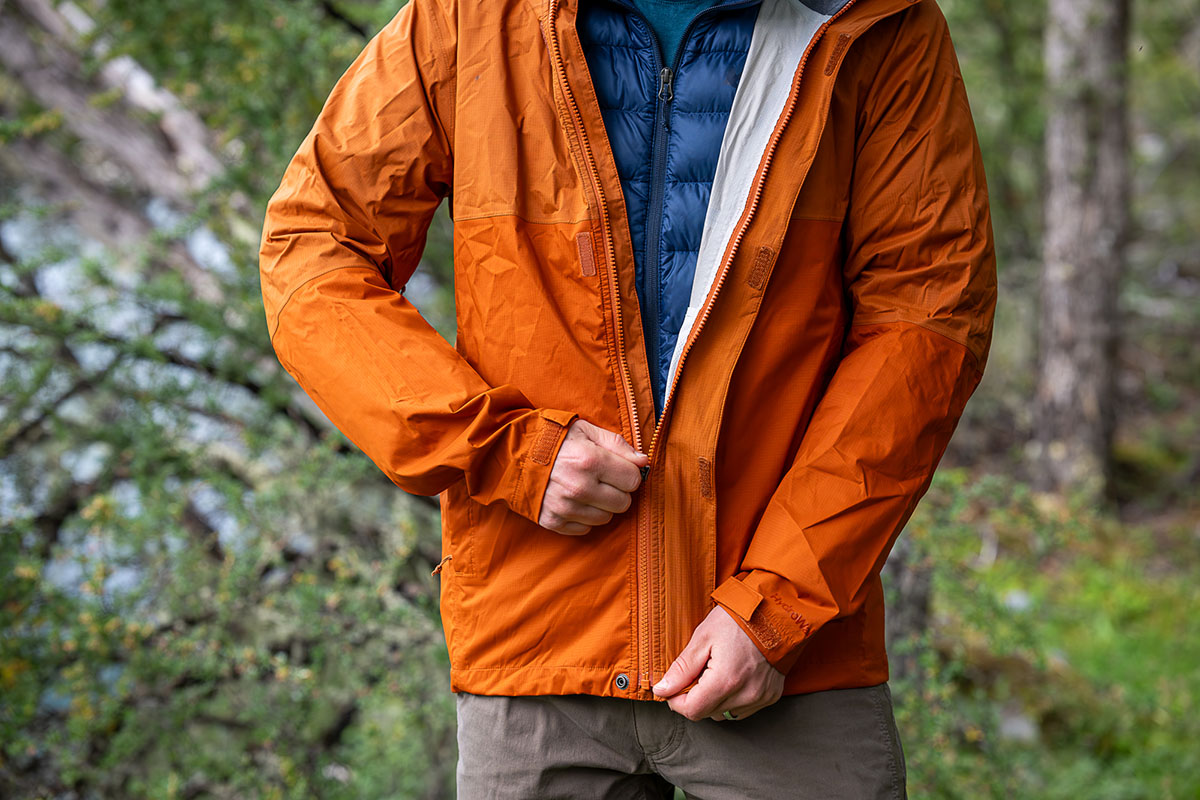
The good news is that most sustainability-conscious brands are transparent about these practices and clearly indicate which (if any) measures each product uses. Patagonia is a clear leader in this realm: Their Torrentshell 3L, for example, uses a 100%-recycled face fabric, PFC-free DWR coating, PU membrane that’s comprised of 13% biobased content, and is both bluesign-approved and Fair Trade Certified, indicating that the materials are safe for consumers and the environment and that workers are treated fairly. Other brands that are competitive in the sustainability realm include REI Co-op, Marmot, and Black Diamond. Arc’teryx has traditionally lagged behind here, but some of their recent releases have begun incorporating best-known practices. All told, there’s still a long ways to go in the industry, but the current trajectory and momentum from many of the key players are encouraging.
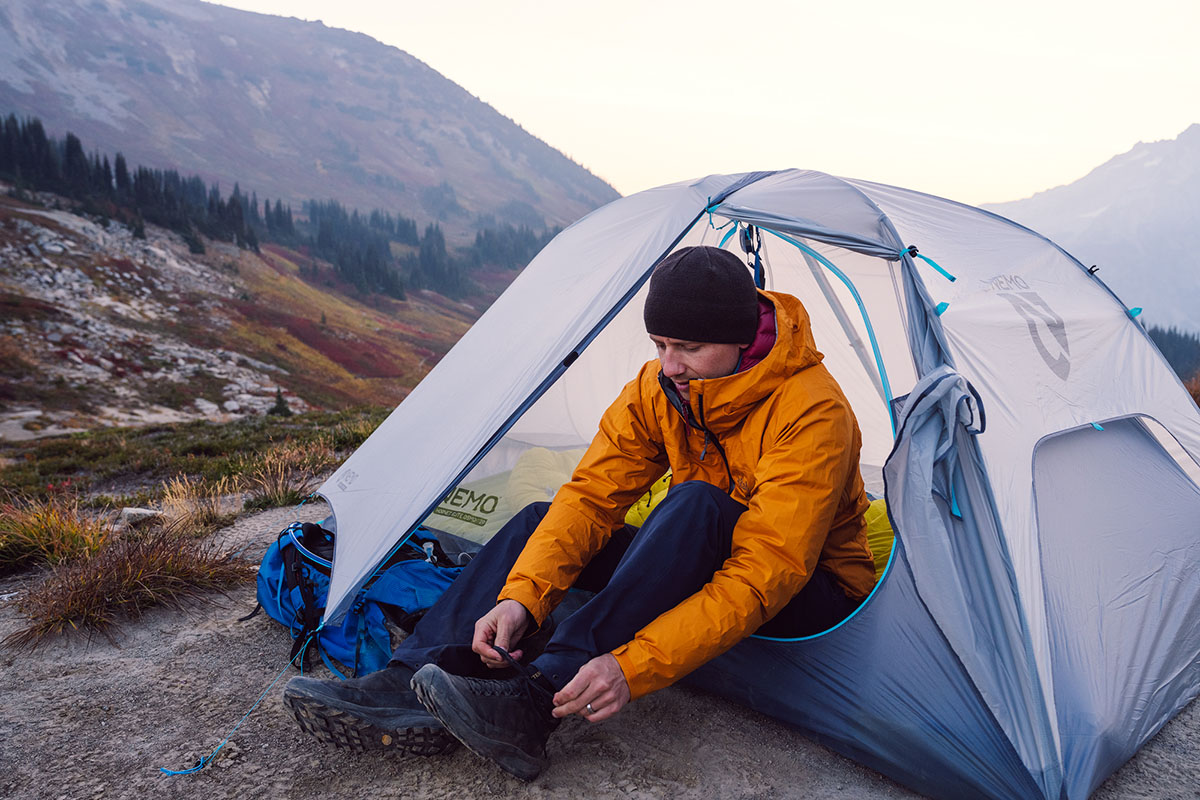
Rain jackets don’t offer as much variation in features as some other types of outdoor gear, but there are notable differences between models. Many ultralight and trail running jackets forego pockets to cut down on weight, while other models sport them in abundance. Some rain jackets offer pit zips and/or full side vents, while basic models do not (as well as taped seams on more expensive rain jackets for extra protection from the elements). Almost all rain jackets have hoods included, but some are cut big enough to fit over a bike or climbing helmet and the style of the cinch varies significantly. Keep a close eye on features and try to match them to your intended use and budget.
Pockets
Casual users appreciate a couple of hand pockets, and that’s one of the most notable omissions in using an ultralight shell for daily use. Most ultralight shells go without hand pockets, instead opting for a chest pocket for storage. On the other hand, more feature-rich shells, such as our hiking/daily use options, hit a better sweet spot for the everyday user. You often get two hand pockets and a chest pocket (either on the inside or outside of the shell), all the better for the little things you need to carry around on a daily basis like a phone or wallet.
.jpg)
Pocket placement is another consideration. Serious shells, such as those offered by Arc’teryx, often place the hand pockets higher up on the torso to avoid interfering with your pack’s hipbelt (they're often referred to as "hipbelt- or harness-compatible." What you gain in convenience with the hipbelt (or climbing harness), you then lose in daily usability. It’s just not as natural a landing spot for your hands. As such, if you plan to wear your rain shell the majority of time around town, it's best to select a rain jacket with hand pockets at the standard height.
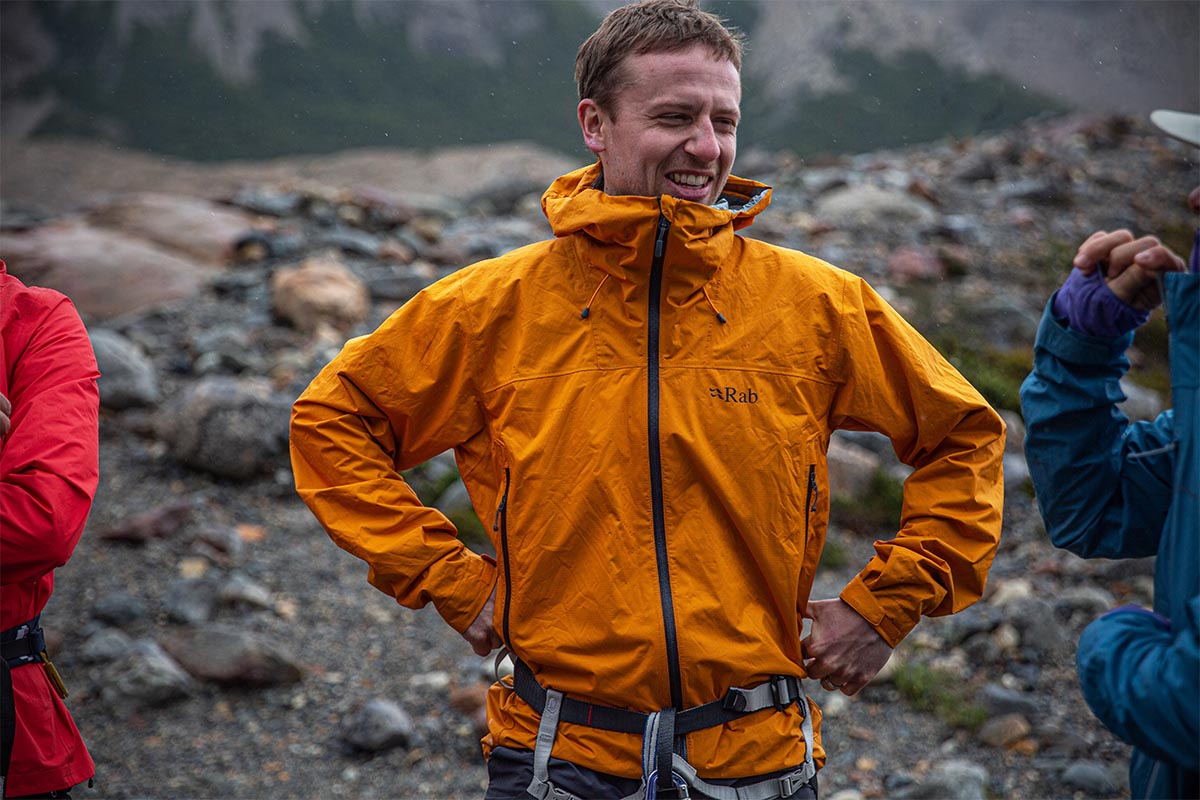
Hood
Hood size can be a big consideration when rain jacket shopping. If you plan to climb in your rain jacket, look for one with a helmet-compatible hood. These can reach over the top of most climbing helmets for added weather protection. But for normal hiking and backpacking, it’s often prudent to avoid this feature as the large hood will require a lot of cinching down, causing the fabrics to bunch up.
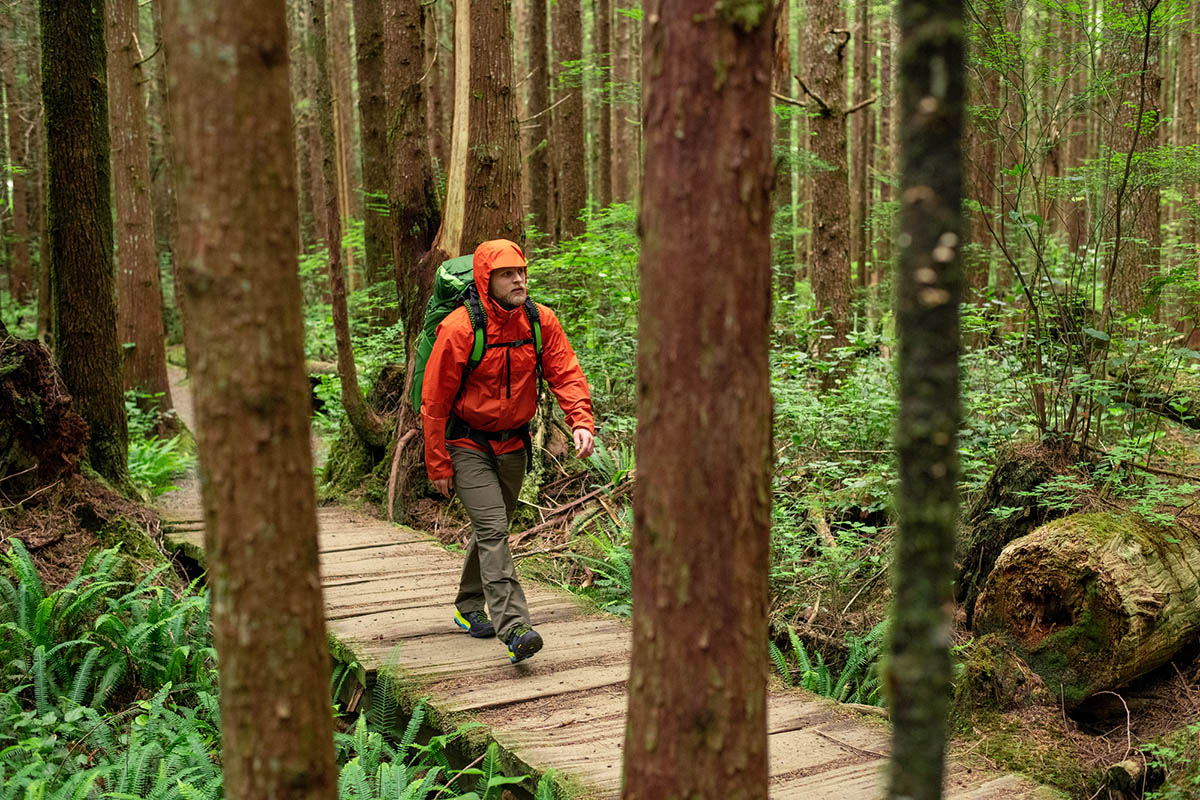
Adjustability of the hood also is key. When the wind is blowing, you want a hood that conforms to your head, while retaining enough structure around the sides and the bill that you can still see out. Some manufacturers succeed better than others at this concept. One standout is Arc’teryx’s StormHood (as seen on the Beta LT): With a single pull at the back of the hood, you adjust evenly around the sides and back of the head. We prefer the toggle style for adjusting the back of the hood over a rip-and-stick Velcro tab for its improved performance. The cord wraps around the sides of your head and pins the fabric down in a uniform way when cinched, which keeps the hood on your head even in really windy conditions. The benefits of the Velcro style are simplicity and weight: They don’t require a cord or toggle, both of which add a bit of bulk.
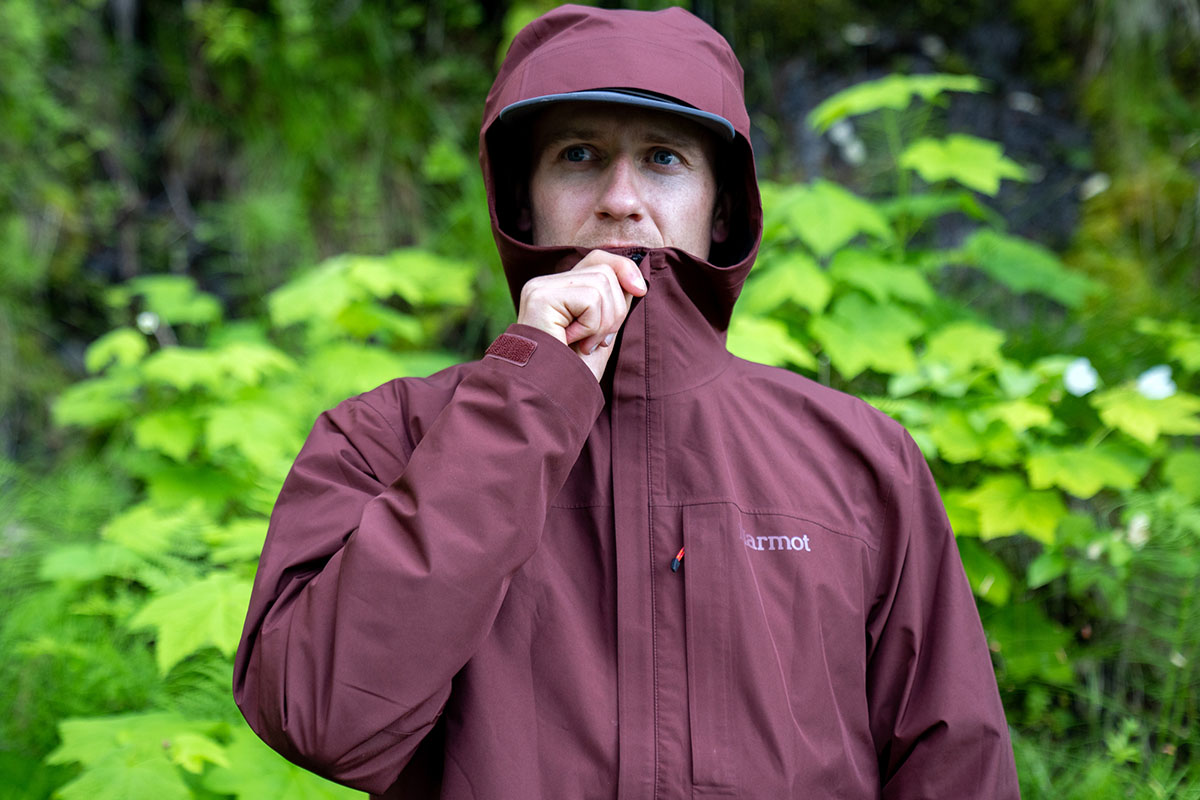
Pit Zips, Side Zips, and Core Vents
In creating a waterproof jacket specifically designed to keep moisture out, there are natural restrictions on the air being held inside. And when you’re working hard, it can quickly become a necessity to dump some of that hot air rather quickly. Enter the pit zip. By opening up the jacket under the arms, you can release a lot of air without sacrificing the jacket’s waterproof design. The ultimate expression of how effective a pit zip can be is the Outdoor Research Foray II. The underarm zippers extend all the way down to the hems on either side. Full unzipped, the jacket becomes a poncho.
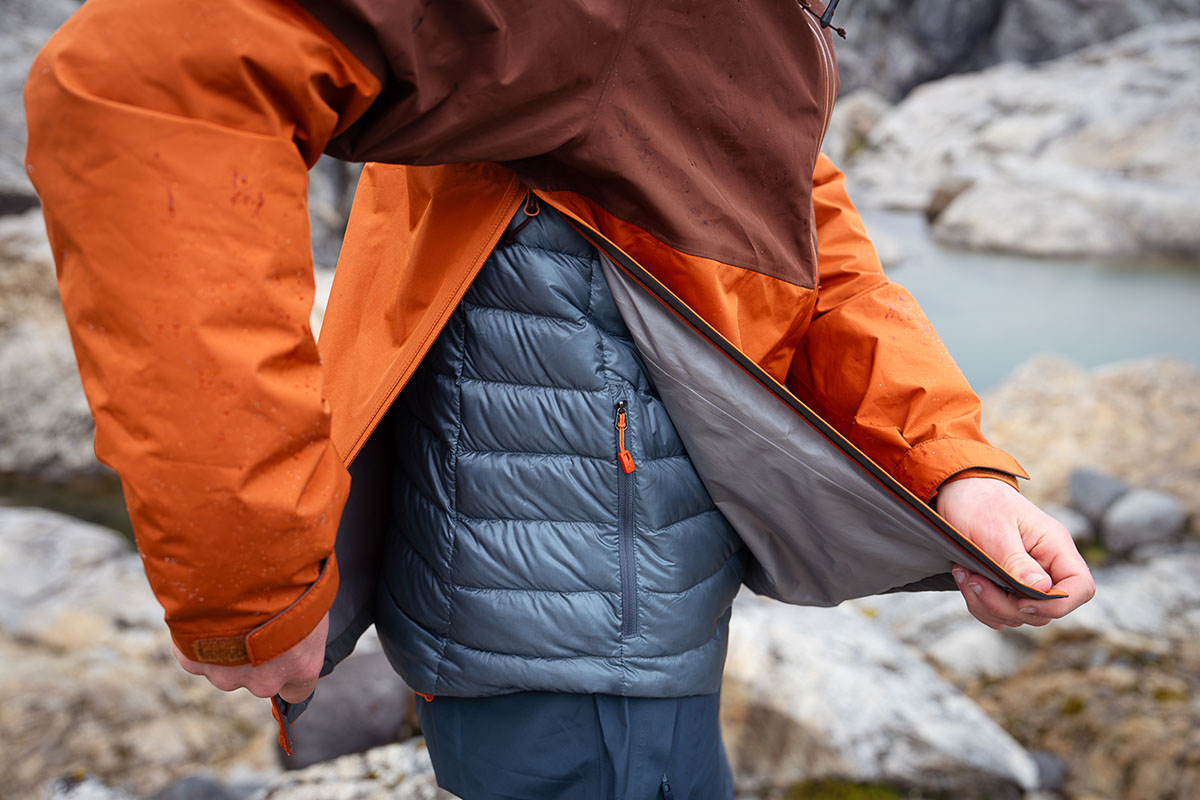
Because adding pit zips to a jacket inevitably results in a slight weight increase, some manufacturers like REI, Rab, and Outdoor Research have come up with a creative solution: core vents. By lining some of their designs' handwarmer pockets with airy mesh, they double as vents when unzipped. It’s not perfect—opening your pockets to vent means that anything stored inside could fall out and it doesn’t dump heat as quickly as the traditional pit zip—but it does save weight while offering a boost in ventilation.
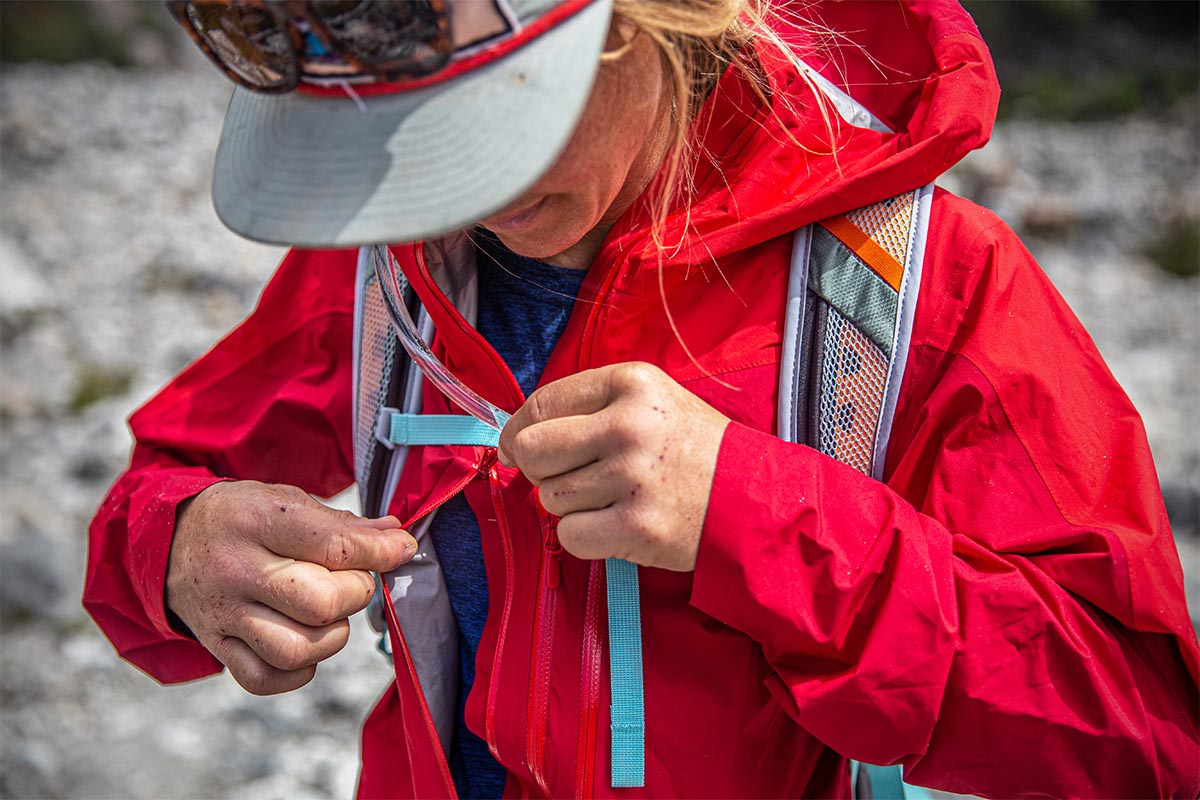
Waist Adjustments
To give the best seal possible, every rain jacket that we recommend here has some sort of cinch system at the hem. Typically done with a cord and toggle, they’re very user-friendly. You’ll see one side cinch on ultralights when the manufacturer is trying to cut some weight. The single cinch does mean if you really have to tighten the jacket, it will pull a bit to one side, but it’s often negligible and worth the weight savings. Heavier rain jackets have cinches on each side for a more even fit.
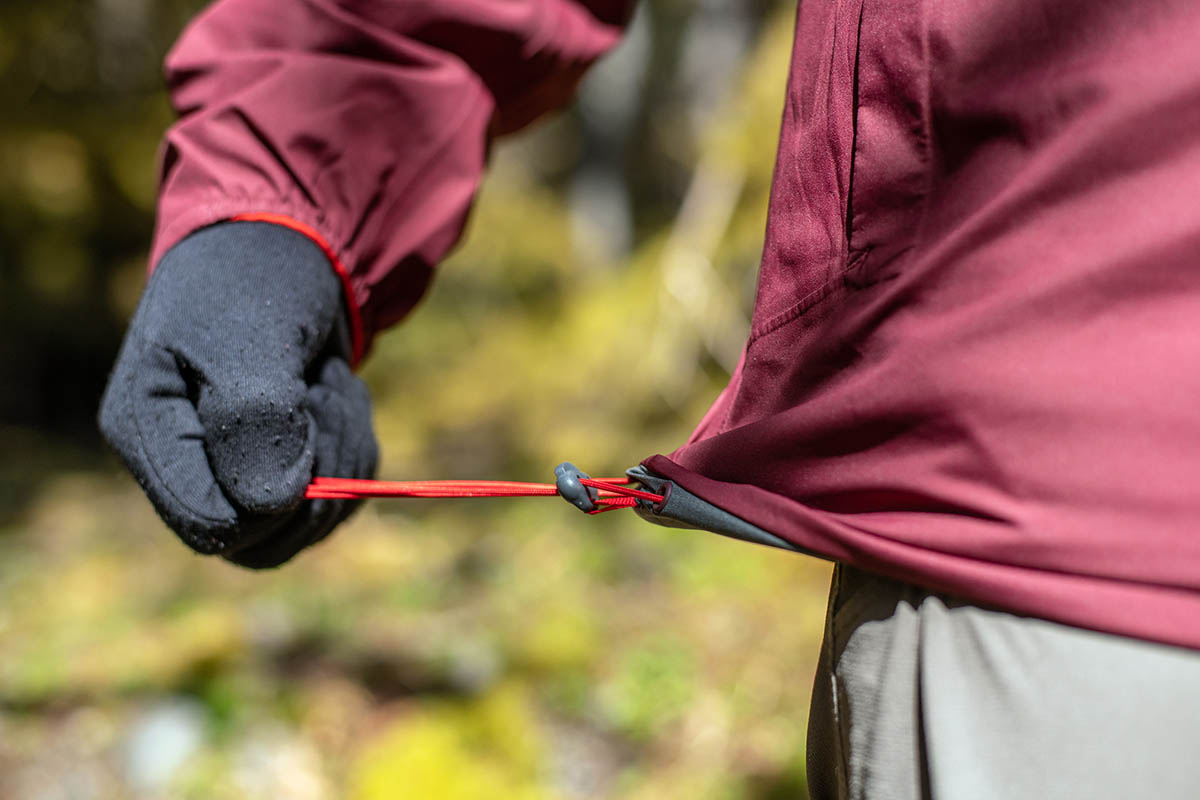
Over the past few years, there have been a growing number of waterproof rain jackets featuring built-in stretch. Designs like Outdoor Research’s Motive and Black Diamond’s StormLine incorporate fabrics and a waterproof internal membrane that flex surprisingly easily. For performance use, the benefits are obvious: While climbing, hiking, or other activities where you’re moving your arms a lot, a stretchy jacket is less restrictive. But we’ve also enjoyed the greater level of comfort and less crinkly feel for daily wear. In general, a stretchy rain jacket will cost more than a standard shell (for example, the BD StormLine is $180 compared with the $120 Marmot PreCip Eco), but it’s a nice upgrade that comes with plenty of tangible benefits.
.jpg)
Traditional softshell jackets are not fully waterproof. While the outer fabric typically has a DWR coating, letting light showers bead up and roll off, the seams aren’t taped and the fabric will eventually let water seep through. Also, a softshell is a bit thicker than a rain jacket, and offers a negligible amount of warmth as a result. Even as technologies have advanced and full waterproof softshells have become available, they still can’t compete with the waterproofing performance of a traditional rain jacket. Instead, softshells remain a better choice for those looking for a breathable and water resistant outer layer. Popular applications include backcountry skiing and trekking in mild weather. For a list of our top picks, you can check out our softshell jacket round-up.
Hardshell jackets, in contrast to the hiking rain jackets we’ve listed above, are made for truly extreme conditions. Built to withstand heavy driving rain and wind, the jackets are heavier and bulkier. Their fabrics are also much less prone to being soaked through under sustained rainfall. As a result of the tough builds, you’ll see these hardshells being used for anything from mountaineering to backcountry skiing. And you’ll also see prices skyrocket for these performance pieces thanks to their high-end detailing. A few rain jackets on this list cross into the lighter end of the hardshell category, including the Outdoor Research Motive, Rab Kinetic Alpine 2.0, and Arc'teryx Beta LT.
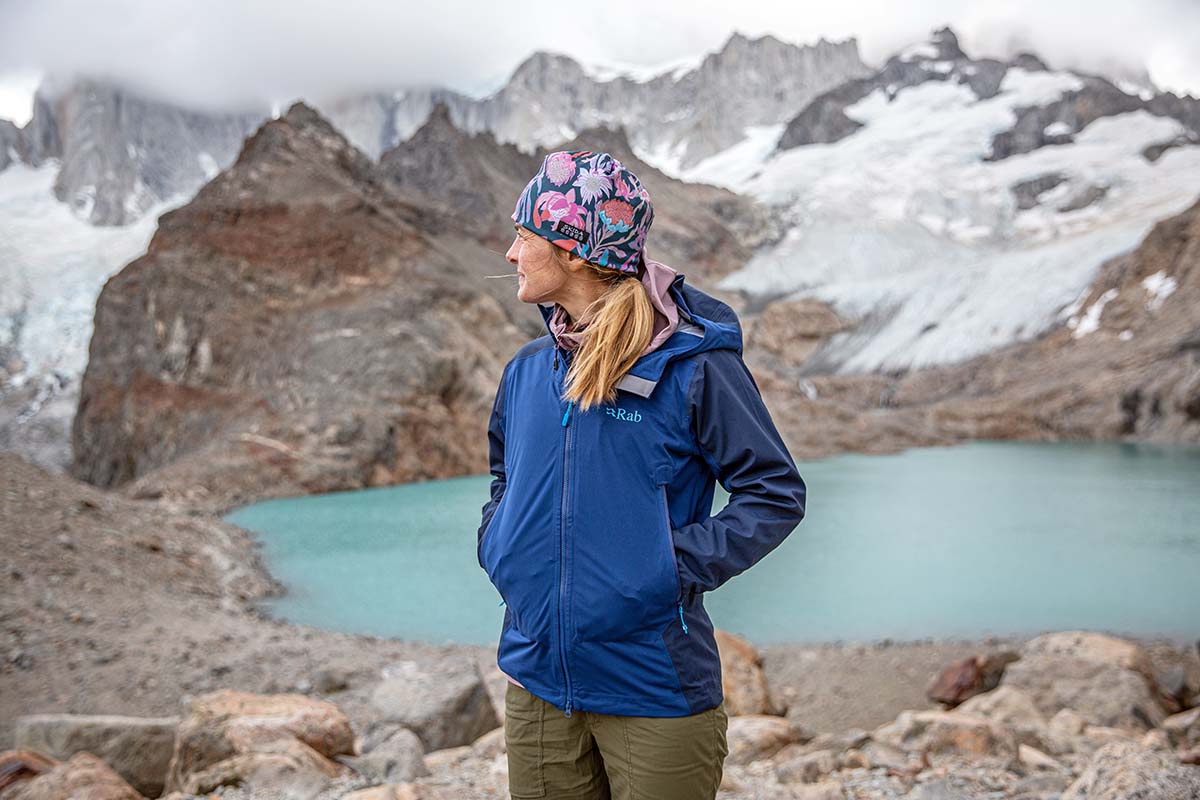
A rain jacket’s waterproofing relies on a combination of factors: durable water repellent (DWR) coating that beads up water, and clean fabric layers on either side of the waterproof and breathable membrane to allow air vapor to pass through. Some membrane designs are more vulnerable to getting clogged up and require consistent cleaning (this will vary based on use, but we aim for every few weeks with our eVent direct venting gear).
For washing, it’s always best to start by checking the label on your jacket as the specific instructions will vary. As a general recommendation, the following works well for us: Wash the jacket in warm water with liquid detergent, and run it through a second rinse cycle to clear out any detergent residue. Line drying typically is best, although we’ve had some eVent and Gore-Tex jackets that instruct you to put it in the dryer on warm heat to replenish the DWR finish.
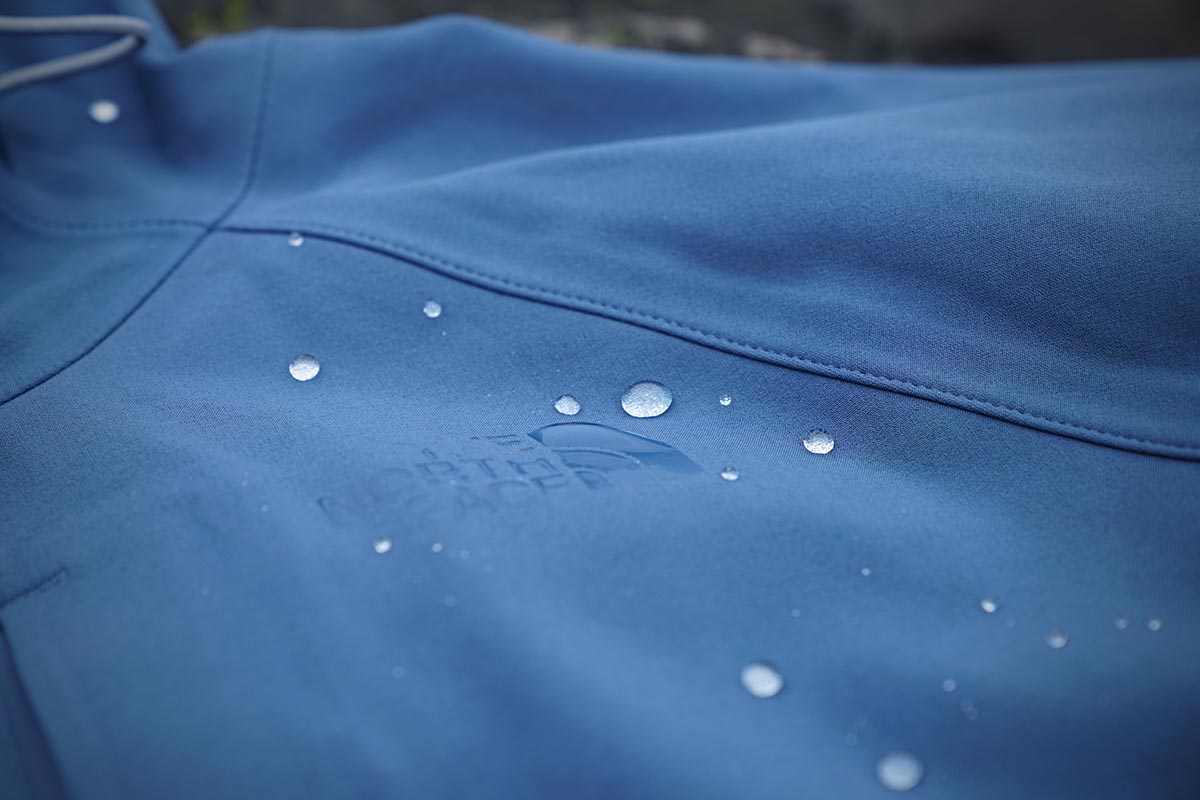
If you’re noticing that the jacket isn’t beading up water anymore and putting it in the dryer for a short stretch doesn’t fix the problem, you may need to reapply some DWR (this is common as the coating diminishes over time). A waterproof jacket without DWR won’t breathe as well in heavy rain because the water will pool up and soak into the exterior fabric layer. Reapplying the DWR is done through a fairly simple process, and we’ve found that the Nikwax TX.Direct Spray-On works well.
Back to Our Top Rain Jacket Picks Back to Our Rain Jacket Comparison Table